Samsung Electronics Co ML-1710 Laser Printer User Manual 1710 EN USER
Samsung Electronics Co Ltd Laser Printer 1710 EN USER
Contents
- 1. Users Manual 1
- 2. Users Manual 2
Users Manual 1
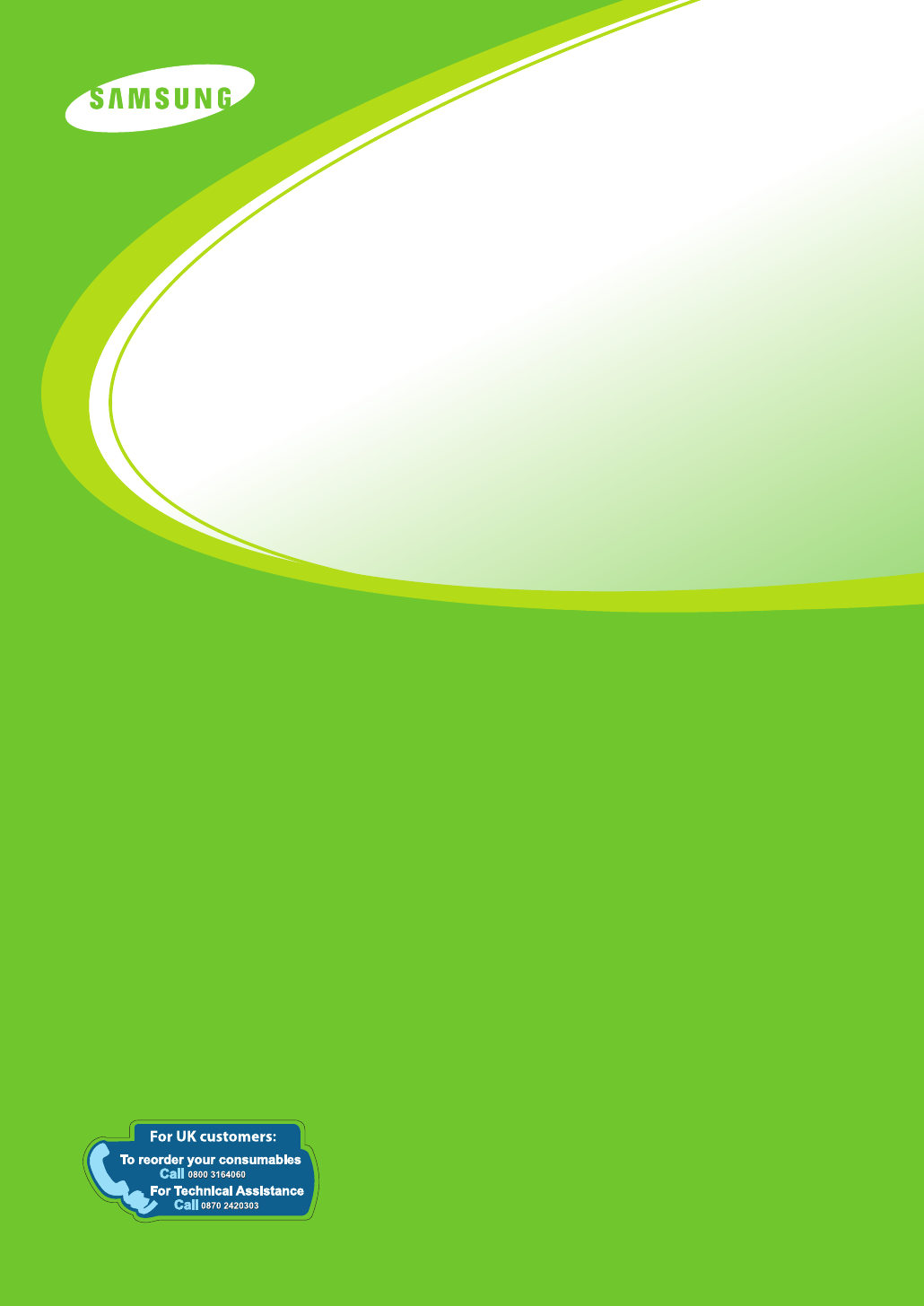
SAMSUNG LASER PRINTER
User’s Guide
ML-1710

i
This manual is provided for information purposes only. All information included herein
is subject to change without notice. Samsung Electronics is not responsible for any
damages, direct or indirect, arising from or related to use of this manual.
© 2002 Samsung Electronics Co., Ltd. All rights reserved.
• ML-1710 and Samsung logo are trademarks of Samsung Electronics Co., Ltd.
• Centronics is a trademark of Centronics Data Computer Corporation.
• IBM and IBM PC are trademarks of International Business Machines Corporation.
• Apple, AppleTalk, TrueType, LaserWriter and Macintosh are trademarks of Apple
Computer, Inc.
• Microsoft, Windows, Windows 98, Windows Me, Windows 2000 and Windows XP are
registered trademarks of Micorsoft Corporation.
• All other brand or product names are trademarks of their respective companies or
organizations.

ii
CONTENTS
Chapter 1:
INTRODUCTION
Special Features .................................................. 1.2
Printer Components ............................................. 1.4
Front View ..................................................... 1.4
Inside View .................................................... 1.5
Rear View ...................................................... 1.5
Understanding the Control Panel ............................ 1.6
On Line/Error and Toner Save LEDs ................... 1.6
Cancel button ................................................. 1.7
Chapter 2:
SETTING UP YOUR PRINTER
Unpacking .......................................................... 2.2
Selecting a Location ........................................ 2.3
Installing the Toner Cartridge ................................ 2.4
Loading Paper ..................................................... 2.6
Changing the Paper Size in the Tray .................. 2.8
Connecting a Printer Cable .................................... 2.9
Turning the Printer on ......................................... 2.10
Printing a Demo Page .......................................... 2.11
Installing Printer Software ................................... 2.12
Printer Driver Features ................................... 2.13
Installing Printer software in Windows .............. 2.14

iii
Chapter 3:
USING PRINT MATERIALS
Choosing Paper and Other Materials ....................... 3.2
Sizes and Capacities ....................................... 3.3
Guidelines for Paper and Special Materials .......... 3.4
Selecting the Output Location ................................ 3.5
Printing to the Top Output Tray (Face down) ...... 3.5
Printing to the Rear Output Tray (Face up) ......... 3.6
Loading Paper ..................................................... 3.7
Using the Tray ................................................ 3.7
Using the Manual Feeder ................................. 3.8
Printing on Envelopes .......................................... 3.10
Printing on Labels ............................................... 3.12
Printing on Transparencies ................................... 3.13
Printing on Card Stock or
Custom-sized Materials ....................................... 3.15
Chapter 4:
PRINTING TASKS
Printing a Document ............................................ 4.2
Canceling a Print Job ....................................... 4.4
Using a Favorite Setting .................................. 4.5
Using Help ..................................................... 4.5
Setting Paper Properties ....................................... 4.6
Using the Toner Save Mode ................................... 4.8
Printing Multiple Pages on One Sheet of Paper
(N-Up Printing) ................................................... 4.10
Scaling Your Document ....................................... 4.12
Fitting Your Document to a Selected Paper Size ...... 4.13
Printing Posters .................................................. 4.14
Setting Graphic Properties ................................... 4.16
Printing Watermarks ........................................... 4.19
Using an existing Watermark ........................... 4.19
Creating a Watermark .................................... 4.20
Editing a Watermark ...................................... 4.21
Deleting a Watermark .................................... 4.21
Printing Overlays ................................................ 4.22
What is an Overlay? ....................................... 4.22
Creating a New Page Overlay .......................... 4.22
Using a Page Overlay ..................................... 4.24
Deleting a Page Overlay ................................. 4.25
Using the Status Monitor ..................................... 4.26
Opening the Status Monitor ............................. 4.26
Setting Up Locally Shared Printer .......................... 4.28
Windows 98/Me ............................................. 4.28
Windows 2000/XP .......................................... 4.29

iv
Chapter 5:
MAINTAINING YOUR PRINTER
Maintaining the Toner Cartridge ............................. 5.2
Redistributing Toner ........................................ 5.3
Replacing the Toner Cartridge .......................... 5.4
Cleaning the Printer ............................................. 5.5
Cleaning the Outside ....................................... 5.5
Cleaning the Inside ......................................... 5.5
Consumables and Replacement Parts ..................... 5.8
Chapter 6:
SOLVING PROBLEMS
Troubleshooting Checklist ..................................... 6.2
Solving General Printing Problems .......................... 6.3
Clearing Paper Jams ............................................. 6.7
In the Paper Exit Area ..................................... 6.7
In the Paper Feed Area .................................... 6.9
Around the Toner Cartridge ............................. 6.10
Tips for Avoiding Paper Jams ........................... 6.11
Solving Print Quality Problems .............................. 6.11
Print Quality Checklist .................................... 6.11
Solving Print Quality Problems ......................... 6.12
Troubleshooting Error Messages ........................... 6.17
Common Windows Problems ................................ 6.18
Common Macintosh Problems ............................... 6.19
Problems in the Chooser ................................. 6.19
Printing Errors ............................................... 6.19
Common Linux Problems ..................................... 6.20
Chapter 7:
APPENDIX
Using Your Printer with a Macintosh ....................... 7.2
Installing Software for Macintosh ...................... 7.2
Printing a Document ....................................... 7.4
Using Advanced Printing Features ..................... 7.6
Using Your Printer in Linux ................................... 7.10
Installing the Printer Driver ............................. 7.10
Changing the Printer Connection Method ........... 7.14
Using the Configuration Tool ........................... 7.16
Changing LLPR Properties ............................... 7.18
Printer Specifications ........................................... 7.20

v
Paper Specifications ............................................ 7.21
Overview ...................................................... 7.21
Supported Sizes of Paper ................................ 7.22
Guidelines for Using Paper .............................. 7.23
Paper Specifications ....................................... 7.24
Paper Output Capacity .................................... 7.24
Printer and Paper Storage Environment ............ 7.25
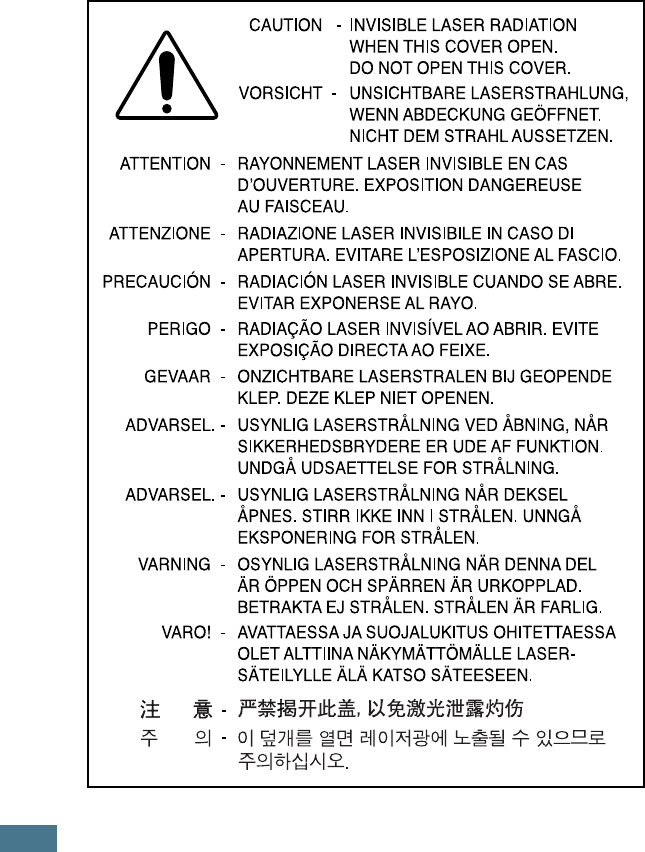
vi
Environmental and Safety Consideration
Laser Safety Statement
The printer is certified in the U.S. to conform to the requirements of DHHS 21 CFR,
chapter 1 Subchapter J for Class I(1) laser products, and elsewhere, is certified as a
Class I laser product conforming to the requirements of IEC 825.
Class I laser products are not considered to be hazardous. The laser system and
printer are designed so there is never any human access to laser radiation above a
Class I level during normal operation, user maintenance, or prescribed service
condition.
WARNING
Never operate or service the printer with the protective cover removed from Laser/
Scanner assembly. The reflected beam, although invisible, can damage your eyes.
When using this product, these basic safety precautions should always be followed to
reduce risk of fire, electric shock, and injury to persons:
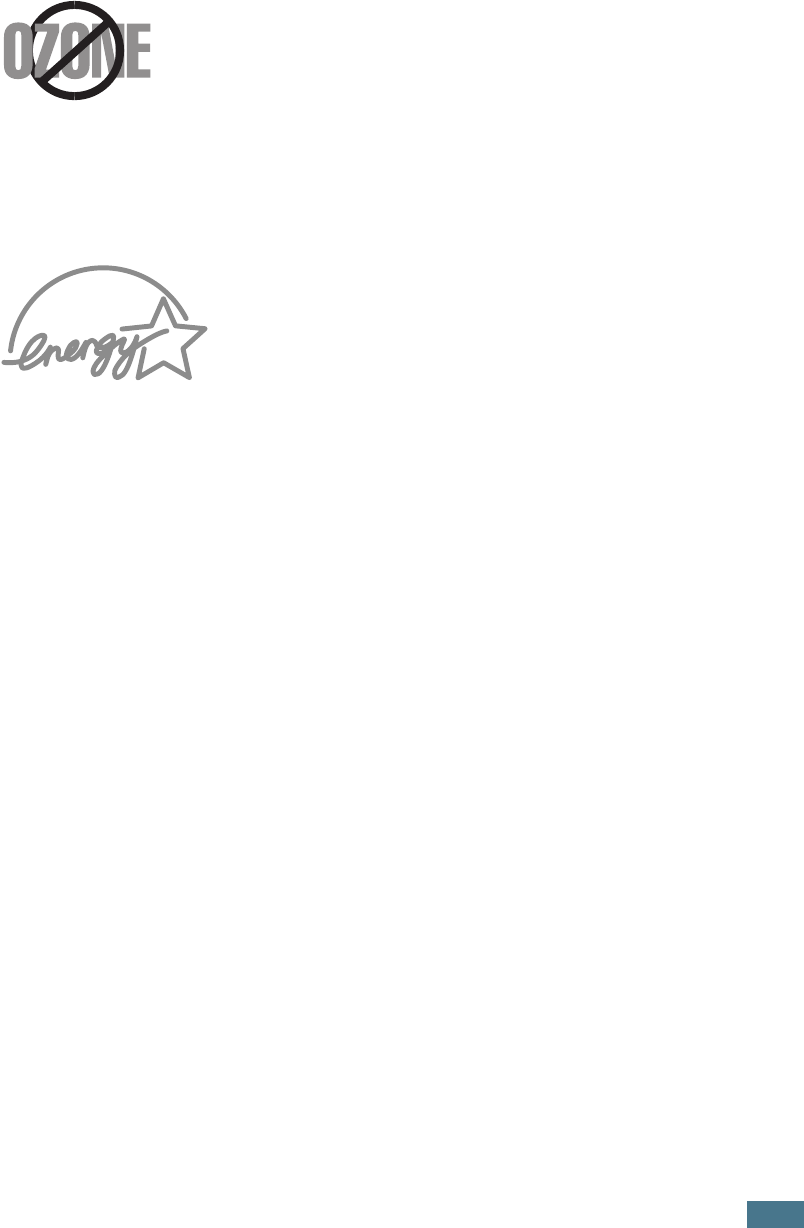
vii
Ozone Safety
During normal operation, this machine produces ozone. The
ozone produced does not present a hazard to the operator.
However, it is advisable that the machine be operated in a well
ventilated area.
If you need additional information about ozone, please contact
your nearest Samsung dealer.
Power Saver
This printer contains advanced energy conservation
technology that reduces power consumption when it is not
in active use.
When the printer does not receive data for an extended
period of time, power consumption is automatically
lowered.
The energy star emblem does not represent EPA
endorsement of any product or service.
Radio Frequency Emissions
FCC regulations
This device has been tested and found to comply with the limits for a Class B digital
device, pursuant to Part 15 of the FCC rules. These limits are designed to provide
reasonable protection against harmful interference in a residential installation. This
equipment generates, uses and can radiate radio frequency energy and, if not
installed and used in accordance with the instructions, may cause harmful
interference to radio communications. However, there is no guarantee that
interference will not occur in a particular installation. If this equipment does cause
harmful interference to radio or television reception, which can be determined by
turning the equipment off and on, the user is encouraged to try to correct the
interference by one or more of the following measures:
1
Reorient or relocate the receiving antenna.
2
Increase the separation between the equipment and receiver.
3
Connect the equipment into an outlet on a circuit different from that to which the
receiver is connected.
4
Consult the dealer or an experienced radio/TV technician for help.
CAUTION: Changes or modifications not expressly approved by the manufacturer
responsible for compliance could void the user’s authority to operate the equipment.

viii
Canadian Radio Interference Regulations
This digital apparatus does not exceed the Class B limits for radio noise emissions
from digital apparatus as set out in the interference-causing equipment standard
entitled “Digital Apparatus”, ICES-003 of the Industry and Science Canada.
Cet appareil numérique respecte les limites de bruits radioélectriques applicables aux
appareils numériques de Classe B prescrites dans la norme sur le matériel brouilleur:
“Appareils Numériques”, ICES-003 édictée par l’Industrie et Sciences Canada.
Declaration of Conformity (European Countries)
Approvals and Certifications
The CE marking applied to this product symbolizes Samsung
Electronics Co., Ltd. Declaration of Conformity with the following
applicable 93/68/EEC Directives of the European Union as of the
dates indicated:
January 1, 1995: Council Directive 73/23/EEC Approximation of the laws of the
member states related to low voltage equipment.
January 1, 1996: Council Directive 89/336/EEC (92/31/EEC), approximation of the
laws of the Member States related to electromagnetic compatibility.
March 9, 1999: Council Directive 1999/5/EC on radio equipment and
telecommunications terminal equipment and the mutual recognition of their
conformity.
A full declaration, defining the relevant Directives and referenced standards can be
obtained from your Samsung Electronics Co., Ltd. representative.
EC Certification
Certification to 1999/5/EC Radio Equipment &
Telecommunications Terminal Equipment Directive (FAX)
This Samsung product has been self-certified by Samsung for pan-European single
terminal connection to the analogue public switched telephone network (PSTN) in
accordance with Directive 1999/5/EC. The product has been designed to work with
the national PSTNs and compatible PBXs of the European countries:
In the event of problems, you should contact the Euro QA Lab of Samsung Electronics
Co., Ltd. in the first instance.
The product has been tested against TBR21 and/or TBR 38. To assist in the use and
application of terminal equipment which complies with this standard, the European
Telecommunication Standards Institute (ETSI) has issued an advisory document (EG
201 121) which contains notes and additional requirements to ensure network
compatibility of TBR21 terminals. The product has been designed against, and is fully
compliant with, all of the relevant advisory notes contained in this document.

ix
Tentative

x
N
OTE

1INTRODUCTION
Congratulations on the purchase of your Printer!
This chapter includes:
• Special Features
• Printer Components
• Understanding the Control Panel

I
NTRODUCTION
1.2
Special Features
Your new printer is equipped with special features that improve
the print quality, giving you a competitive edge. You can:
Print with excellent quality and high speed
• You can print at 600 dots per inch (dpi). See page 4.16.
• Prints 17 pages-per-minute (Letter size),
16 pages-per-minute(A4 size).
Handle paper flexibly
• Standard 250-sheet tray and a 1-sheet Manual Feeder
support various sizes and types of paper.
• Two output tray; select either the top output tray (face-
down) or the rear output tray (face-up) for the most
convenient access.
Create professional documents
• You can customize your documents using Watermarks, such
as “Confidential.” See page 4.19.
• Print Posters. The text and pictures of each page of your
document are magnified and printed across the selected sheet
of paper. After the document has printed, trim off the white
edges of each sheet. Tape the sheets together to form a
poster. See page 4.14.
WORLD BEST
Dear ABC
Regards
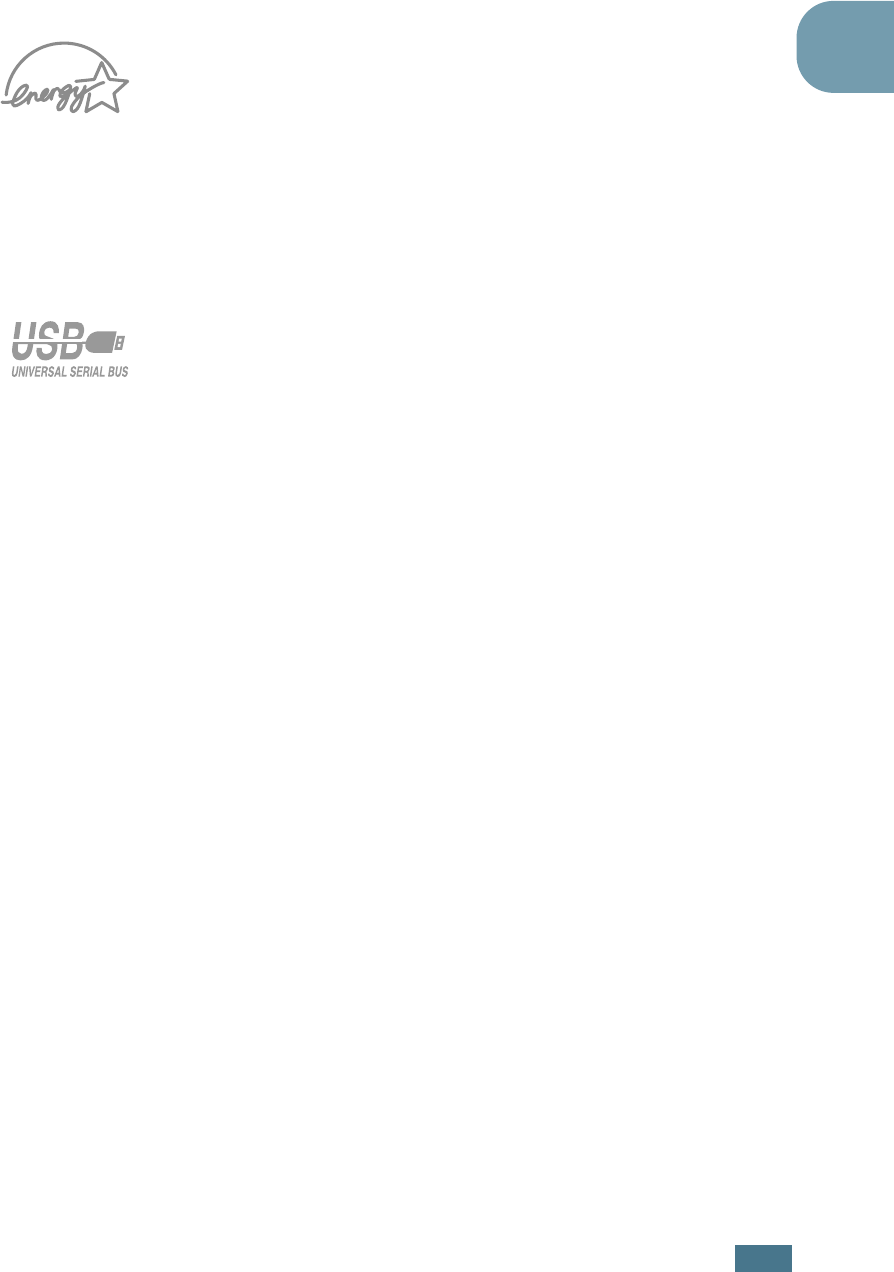
I
NTRODUCTION
1.3
1
Save your time and money
• Allows you to use the Toner Save mode to save toner. See
page 4.8.
• Allows you to print multiple pages on one single sheet of paper
to save paper (N-Up printing). See page 4.10.
• This printer meets Energy Star guidelines for energy
efficiency.
Print in various environments
• You can print in Windows 98/Me/2000/XP.
• Your printer is compatible with Linux and Macintosh.
• Your printer comes with the USB interface.

I
NTRODUCTION
1.4
Printer Components
Front View
Manual Feeder guide
Tray
Front
Cover
Top output tray
(Face down)
Control Panel
Power switch
Output Support
Manual Feeder
Paper level indicator
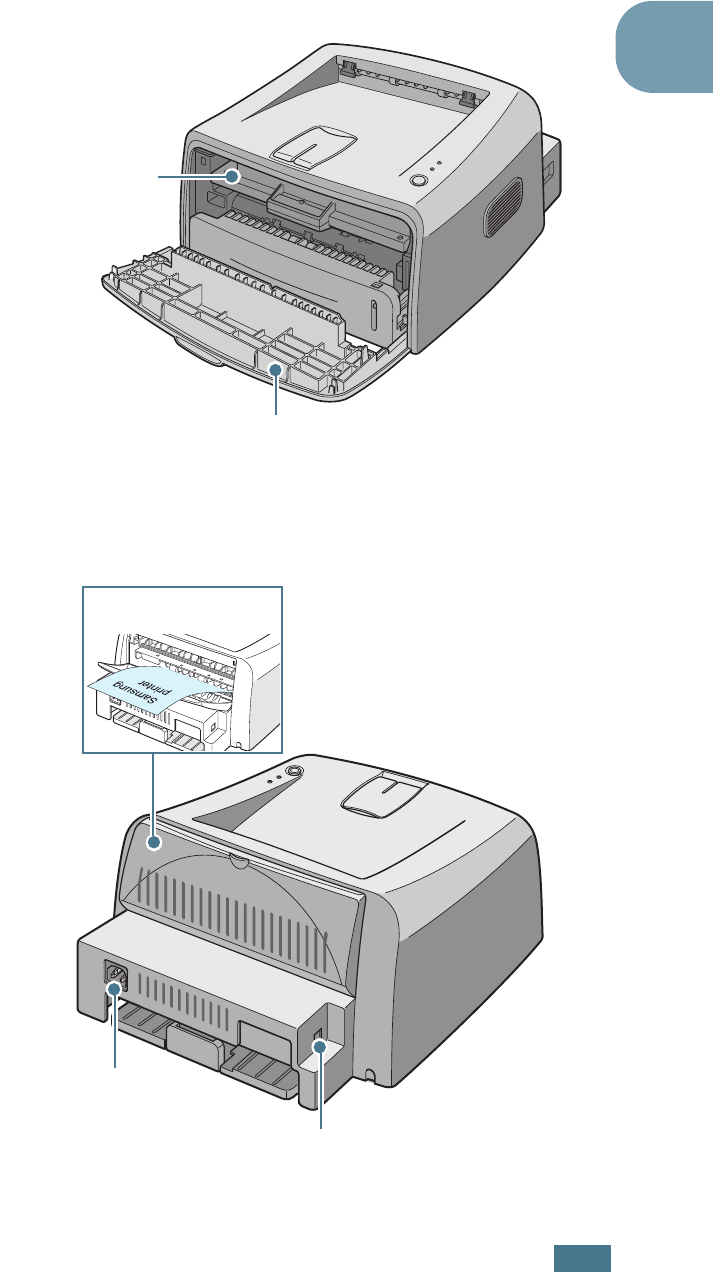
I
NTRODUCTION
1.5
1
Inside View
Rear View
Toner cartridge
Front Cover
Rear output tray
(Face up)
USB port
Power receptacle
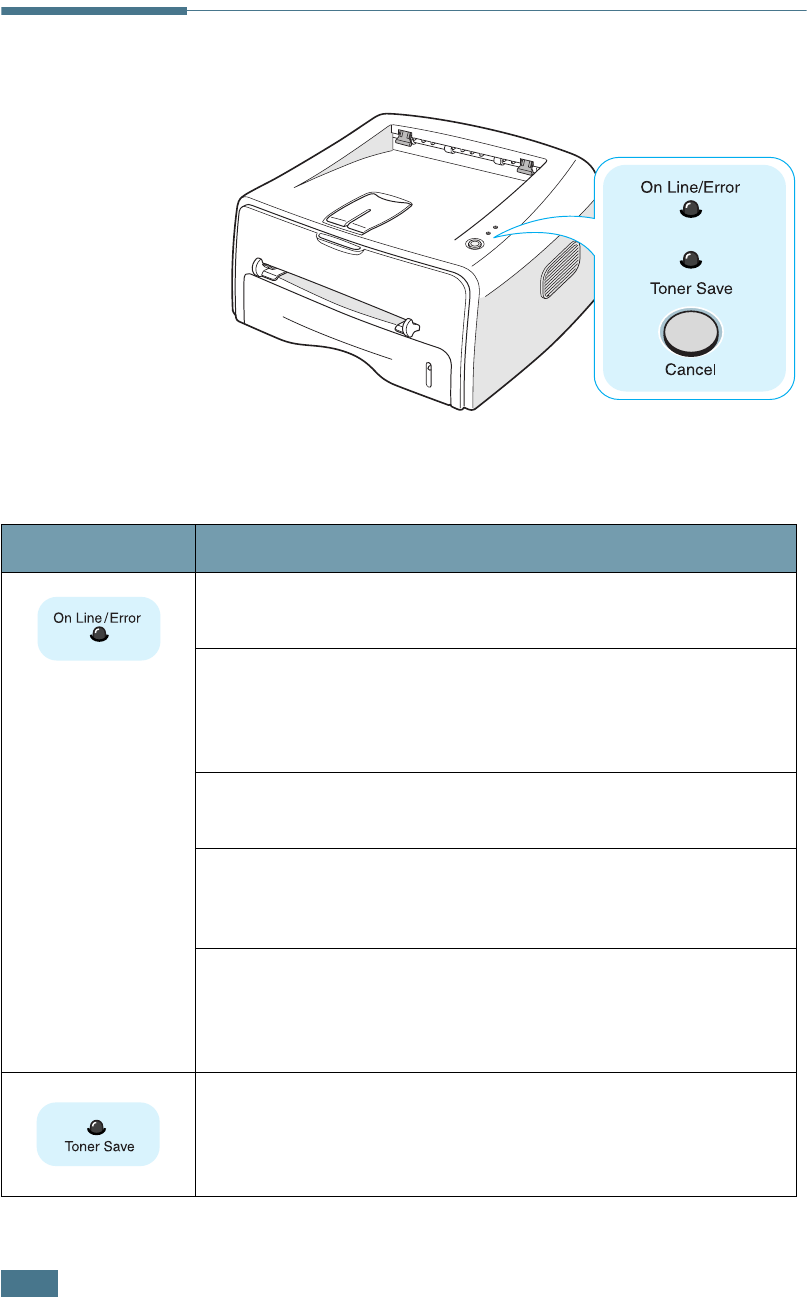
I
NTRODUCTION
1.6
Understanding the Control Panel
On Line/Error and Toner Save LEDs
LED Description
If the
On Line/Error
lights green, the printer is ready to
print.
If the
On Line/Error
lights red, the printer is experiencing
an error, such as jammed paper, the open cover or the empty
toner cartridge. See “Troubleshooting Error Messages” on
page 6.17.
If you press the
Cancel
button while the printer is receiving
data, the
On Line/Error
LED blinks red to cancel printing.
In Manual Feed mode, if there is no paper in the Manual
Feeder, the
On Line/Error
LED blinks red. Load paper into
the Manual Feeder and the LED stops blinking.
If the printer is receiving data, the
On Line/Error
LED
slowly blinks green.
If the printer is printing the received data, the
On Line/
Error
LED blinks green fast.
If you press the
Cancel
button in Ready mode, this LED is on
and the Toner Save mode is enabled.
If you press this button once again, this LED is off and the
Toner Save mode is disabled.
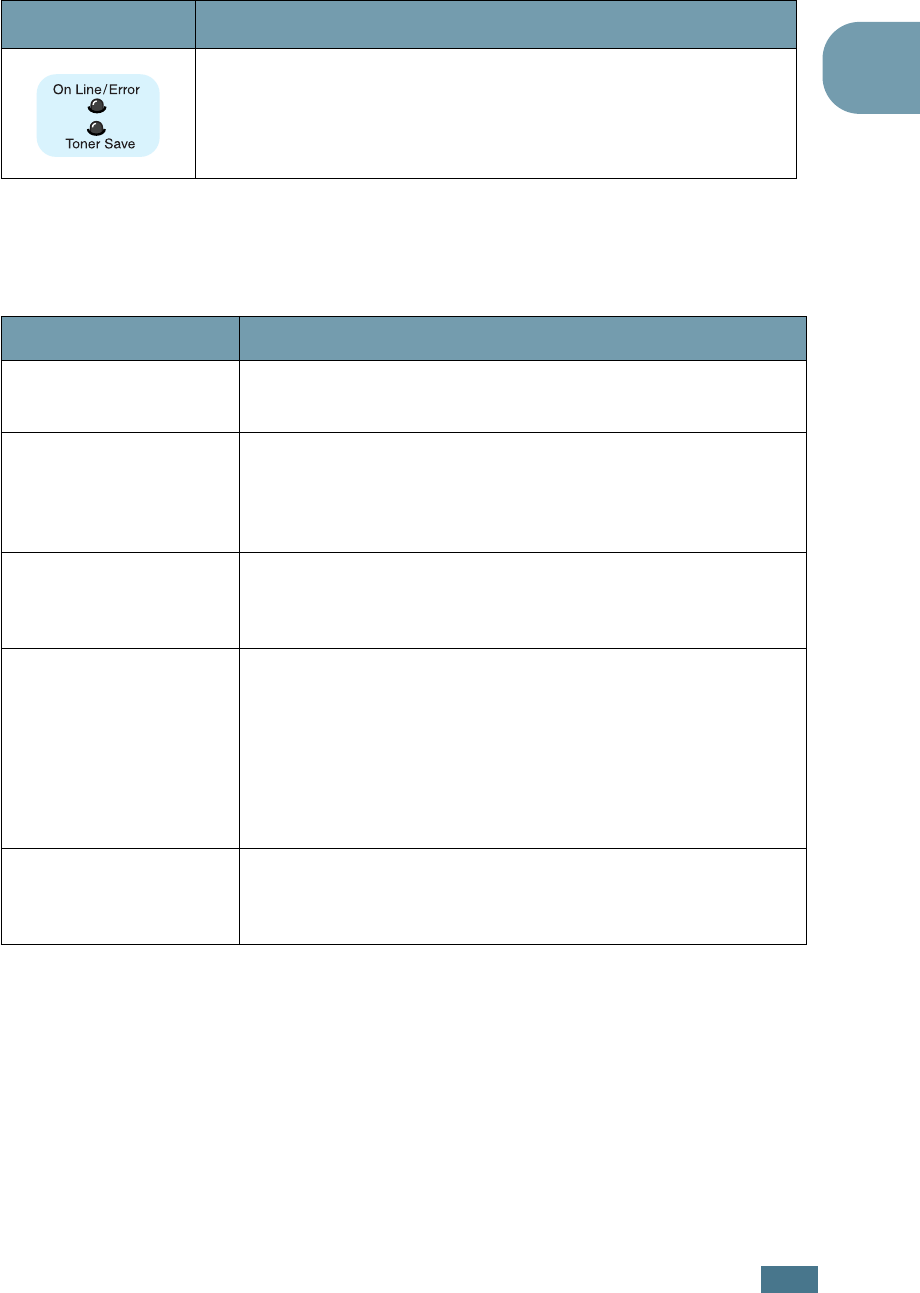
I
NTRODUCTION
1.7
1
Cancel button
If the
On Line/Error
and
Toner Save
LEDs blink, your
system has some problems. To solve the problem, see
“Troubleshooting Error Messages” on page 6.17.
LED Description
Function Description
Printing demo page
In Ready mode, press and hold this button for about 2
seconds until all LEDs blink slowly, and release.
Manual feeding
Press this button each time you load a sheet of paper in the
manual feeder, when you select
Manual Feed
for
Source
from your software application. For detailed information,
see “Using the Manual Feeder” on page 3.8.
Cleaning inside
printer
In Ready mode, press and hold this button for about 10
seconds until all LEDs turn on, and release. After cleaning
the printer, one cleaning sheet prints.
Canceling print job
Press this button during printing. The
On Line/Error
LED
blinks while the print job is cleared from both the printer
and the computer, and then return to Ready mode. This
may take some time depending on the size of the print job.
In Manual Feed mode, you can’t cancel the print job by
pressing this button. For detailed information, see “Using
the Manual Feeder” on page 3.8.
Toner Save mode
on/off
In Ready mode, press this button to turn the Toner Save
mode on or off.
For detailed information, see page 4.8.
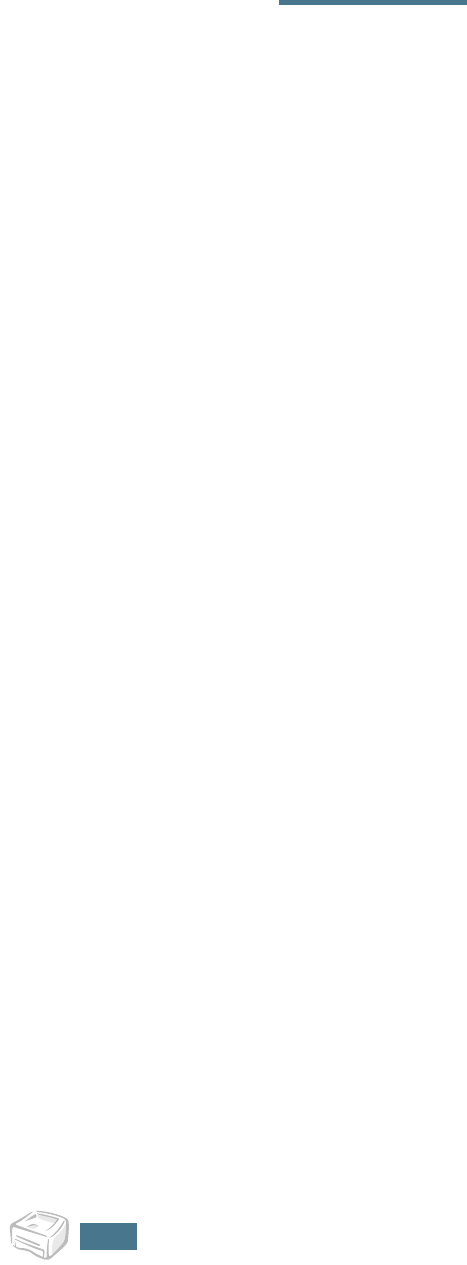
I
NTRODUCTION
1.8
N
OTE

2
This chapter provides step by step information on setting up
your printer.
This chapter includes:
• Unpacking
• Installing the Toner Cartridge
• Loading Paper
• Connecting a Printer Cable
• Turning the Printer on
• Printing a Demo Page
• Installing Printer Software
Setting Up Your Printer

S
ETTING
U
P
Y
OUR
P
RINTER
2.2
Unpacking
1
Remove the Printer and all accessories from the packing
carton. Make sure that the printer has been packed with the
following items:
Notes:
• If any items are missing or damaged, notify your dealer
immediately.
• Components may differ from one country to another.
• The CD-ROM contains the printer driver, the User’s Guide, and
the Adobe Acrobat Reader program.
2
Carefully remove all of packing tapes from the printer.
Toner Cartridge Power Cord
CD-ROM Setup Guide
Tape

S
ETTING
U
P
Y
OUR
P
RINTER
2.3
2
Selecting a Location
Select a level, stable place with adequate space for air
circulation. Allow extra space for opening covers and tray. The
area should be well-ventilated and away from direct sunlight or
sources of heat, cold, and humidity. See the image below for
clearance space. Do not set the printer close to the edge of your
desk or table!
Clearance
Space
•Front: 482.6 mm (enough space so that tray can be
removed)
•Back: 100 mm (enough space to allow opening of the rear
out tray)
•Right: 100 mm (enough space for ventilation)
•Left: 100 mm
552 mm(21.7 in.)
100 mm
(3.9 in.)
954.6 mm(37.5 in.)
482.6 mm(18.8 in.)
100 mm
(3.9 in.)
100 mm
(3.9 in.)
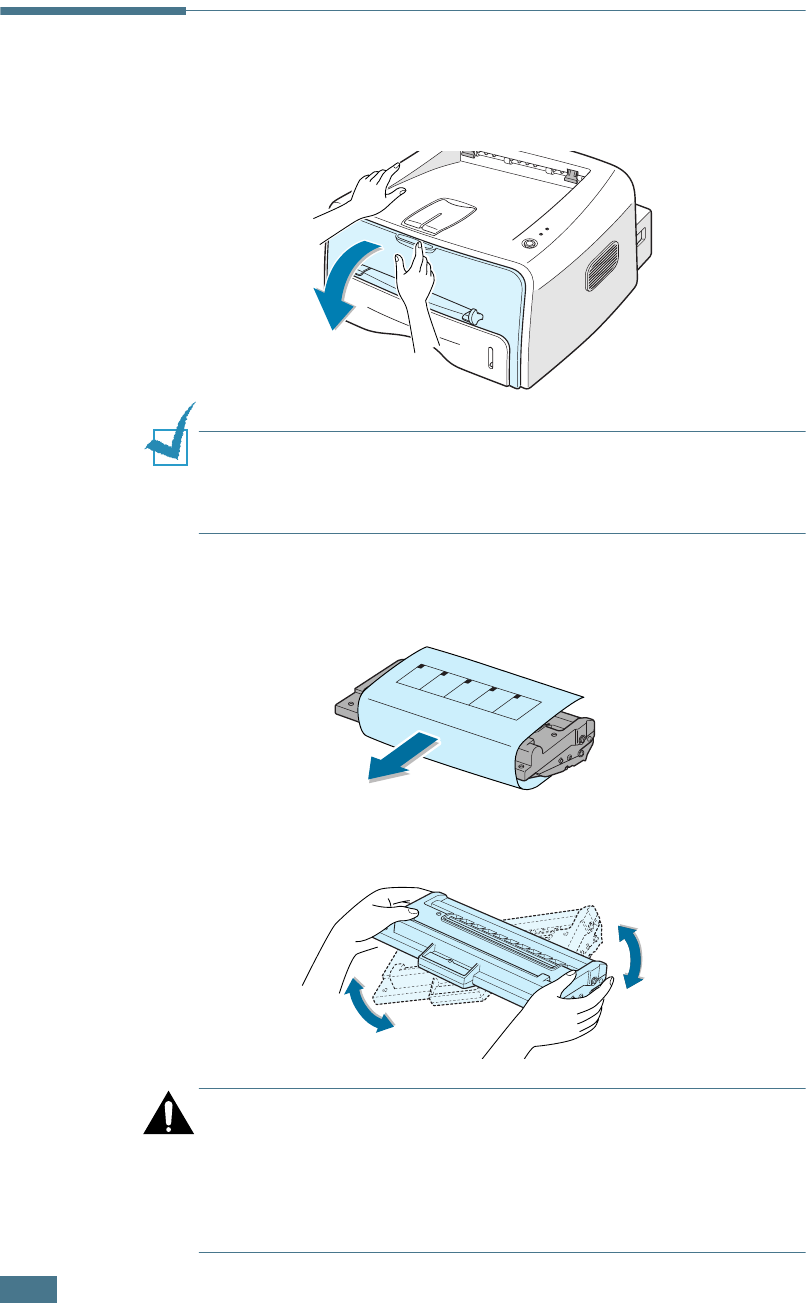
S
ETTING
U
P
Y
OUR
P
RINTER
2.4
Installing the Toner Cartridge
1
Grasp the front cover and pull it toward you to open.
Note: Because the printer is very light, it may be moved when you
use it; for example, when opening/closing the tray or installing/
removing the toner cartridge or installing. Be careful not to move
the printer.
2
Remove the toner cartridge from its bag and remove the
paper covering the cartridge. Discard it.
3
Gently shake the cartridge from side to side to distribute
the toner evenly inside the cartridge.
CAUTION:
• To prevent damage, do not expose the toner cartridge to light for
more than a few minutes. Cover it with a piece of paper, if left
exposed for more than a few minutes.
• If toner gets on your clothing, wipe it off with a dry cloth and
wash clothing in cold water. Hot water sets toner into fabric.

S
ETTING
U
P
Y
OUR
P
RINTER
2.5
2
4
Locate the cartridge slots inside the printer, one on each
side.
5
Grasp the handle and insert the cartridge in the printer until
it snaps into place.
6
Close the front cover. Make sure that the cover is securely
closed.
Note: When printing text at 5% coverage, you can expect a toner
cartridge life of approximately 3,000 pages (1,000 pages for the
toner cartridge that is shipped with the printer).
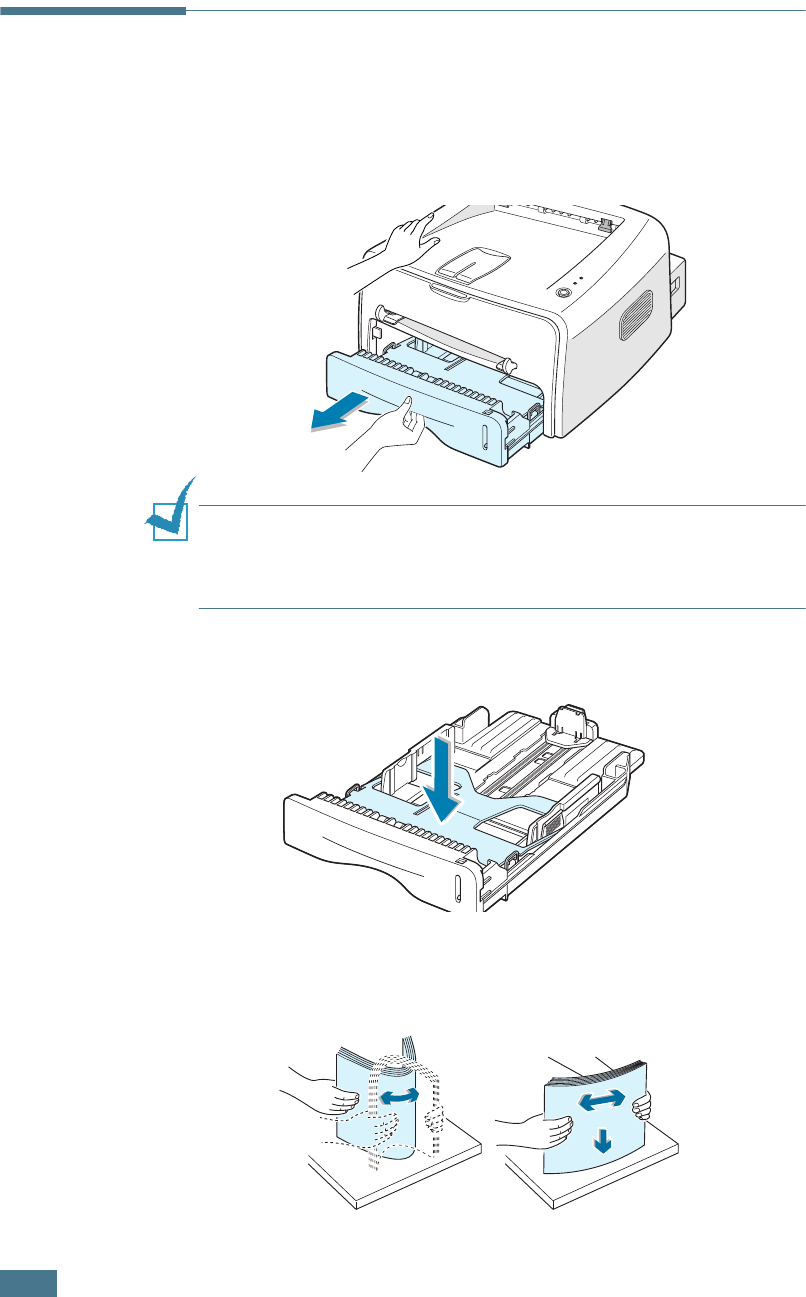
S
ETTING
U
P
Y
OUR
P
RINTER
2.6
Loading Paper
You can load approximately 250 sheets of paper in the tray.
1
Pull the tray out of the printer.
Note: Because the printer is very light, it may be moved when you
use it; for example, when opening/closing the tray or installing/
removing the toner cartridge or installing. Be careful not to move
the printer.
2
Push down on the pressure plate until it locks in position.
3
Prepare a stack of paper for loading by flexing or fanning
them back and forth. Straighten the edges on a level
surface.
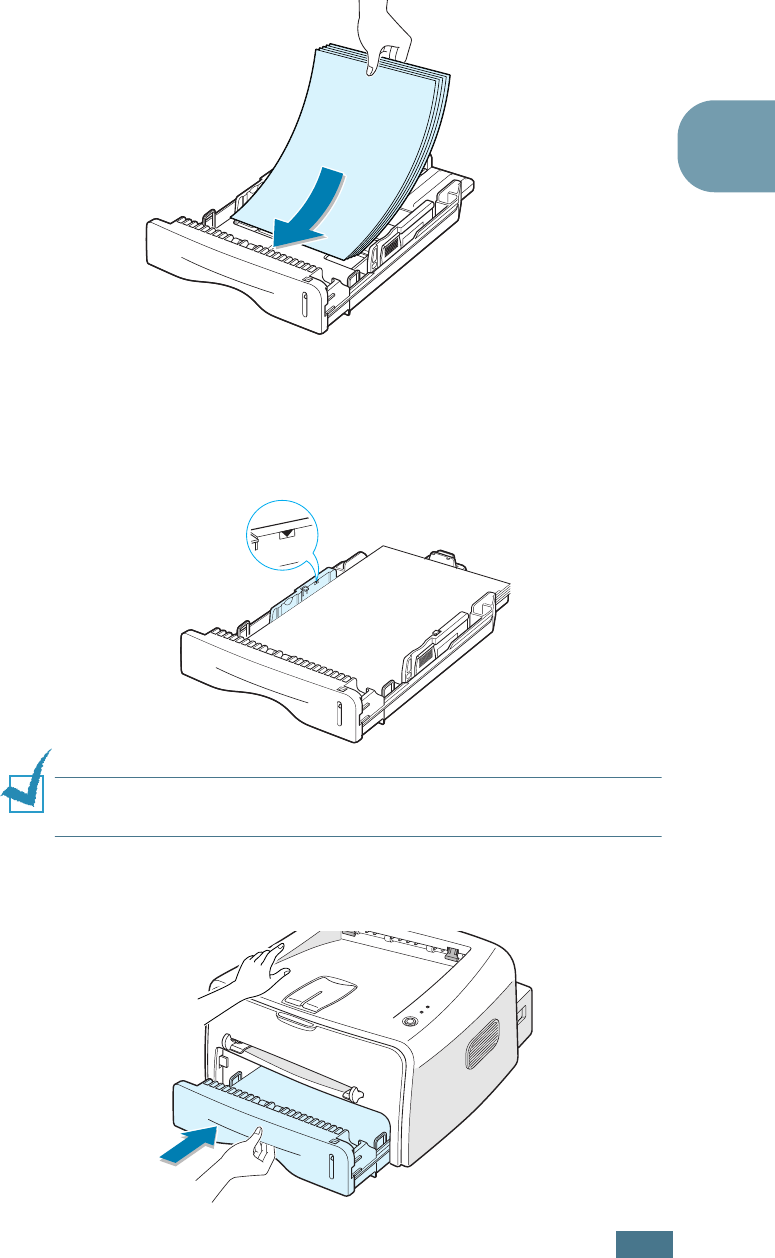
S
ETTING
U
P
Y
OUR
P
RINTER
2.7
2
4
Load paper with the print side facing down.
Make sure that all four corners are flat in the tray.
5
Pay attention to the paper limit mark on the left inside wall
of the tray. Paper overloading may cause paper jams.
Note: If you want to change the paper size in the tray, see
“Changing the Paper Size in the Tray” on page 2.8.
6
Slide the tray back into the printer.

S
ETTING
U
P
Y
OUR
P
RINTER
2.8
Changing the Paper Size in the Tray
1
Pinch the rear guide as shown below to adjust for the paper
length.
2
Pinch the side guide as shown and slide it to the left flush
against the paper.
Notes:
• Do not push the width guide far enough to cause the material to
warp.
• If you do not adjust the width guide, it may cause paper jam.
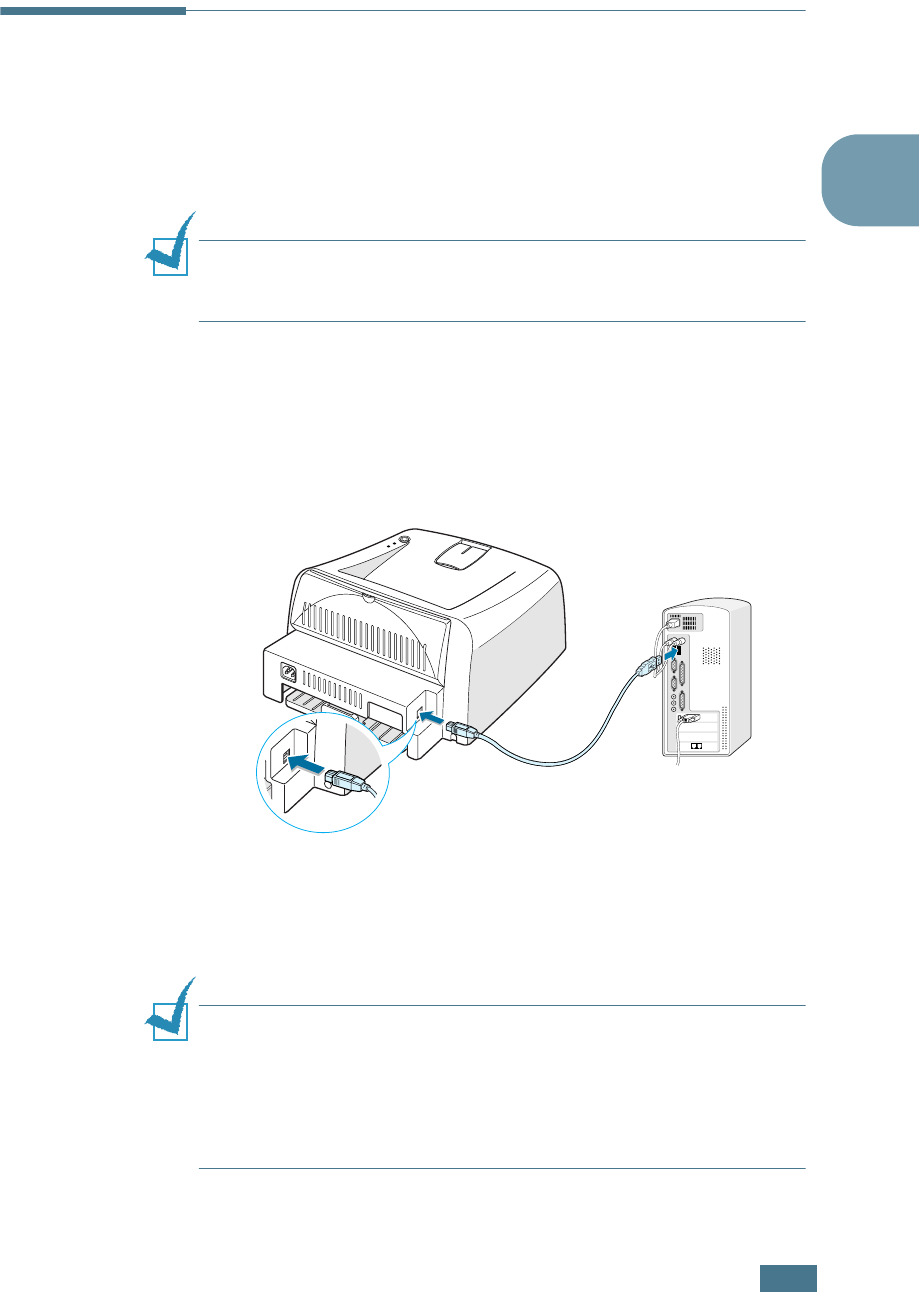
S
ETTING
U
P
Y
OUR
P
RINTER
2.9
2
Connecting a Printer Cable
To print from your computer, you need to connect your printer
to your computer with either a Universal Serial Bus (USB) cable.
Using a USB Cable
Note: Connecting the printer to the USB port of the computer
requires a certified USB cable. You will need to buy a USB 1.1
compliant cable that is within 3m in length.
1
Make sure that both the printer and the computer are
turned off.
2
Plug the USB printer cable into the connector on the back of
the printer.
3
Connect the other end of the cable to the USB port on your
computer.
See your computer User’s Guide if you need help.
Note:
• For using a USB cable, you must be running Windows 98/Me/
2000/XP, or Macintosh with OS 8.6 and the G3 processor or
higher.
• In Windows 98/Me, you must install the USB driver to add the
USB port. See page 2.15.
To the USB port on
your computer
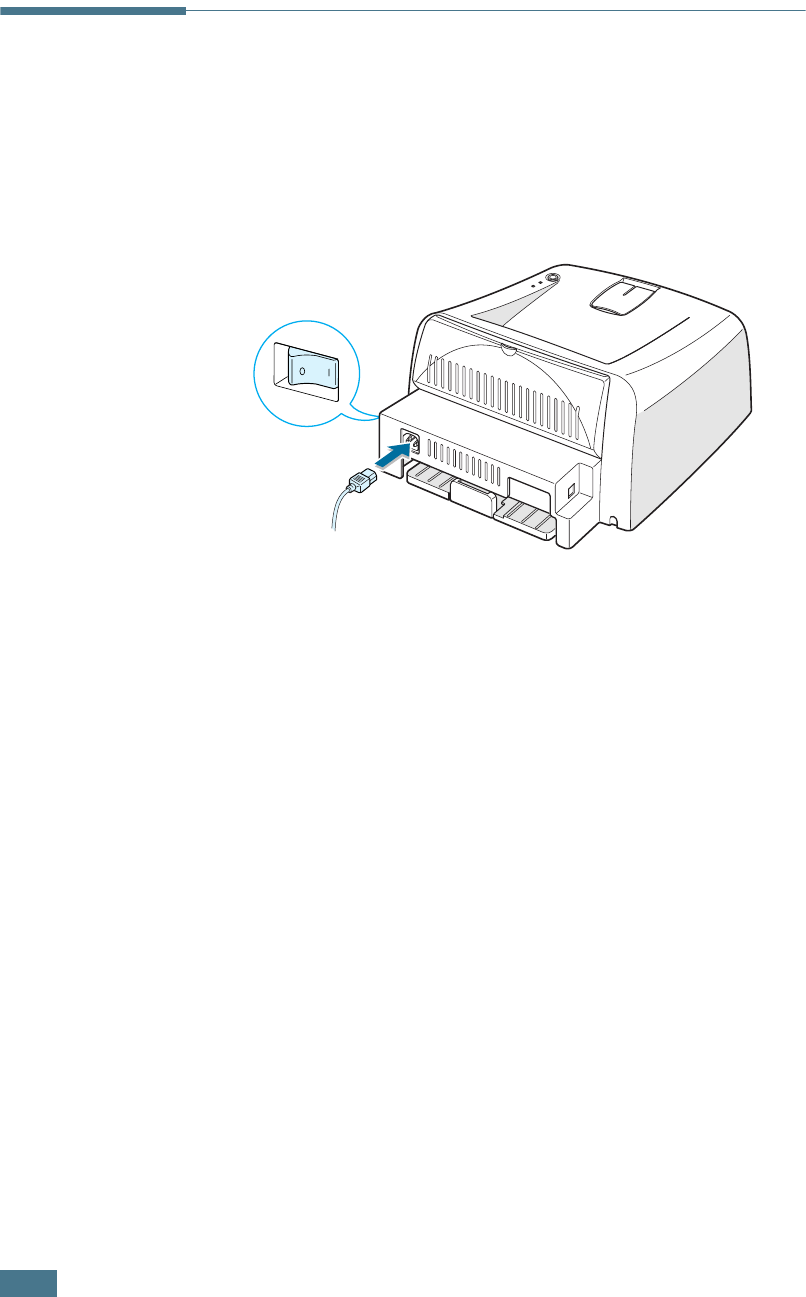
S
ETTING
U
P
Y
OUR
P
RINTER
2.10
Turning the Printer on
1
Plug the power cord into the power receptacle on the back
of the printer.
2
Plug the other end into a properly grounded AC outlet and
turn on the printer using the power switch.
To the AC outlet
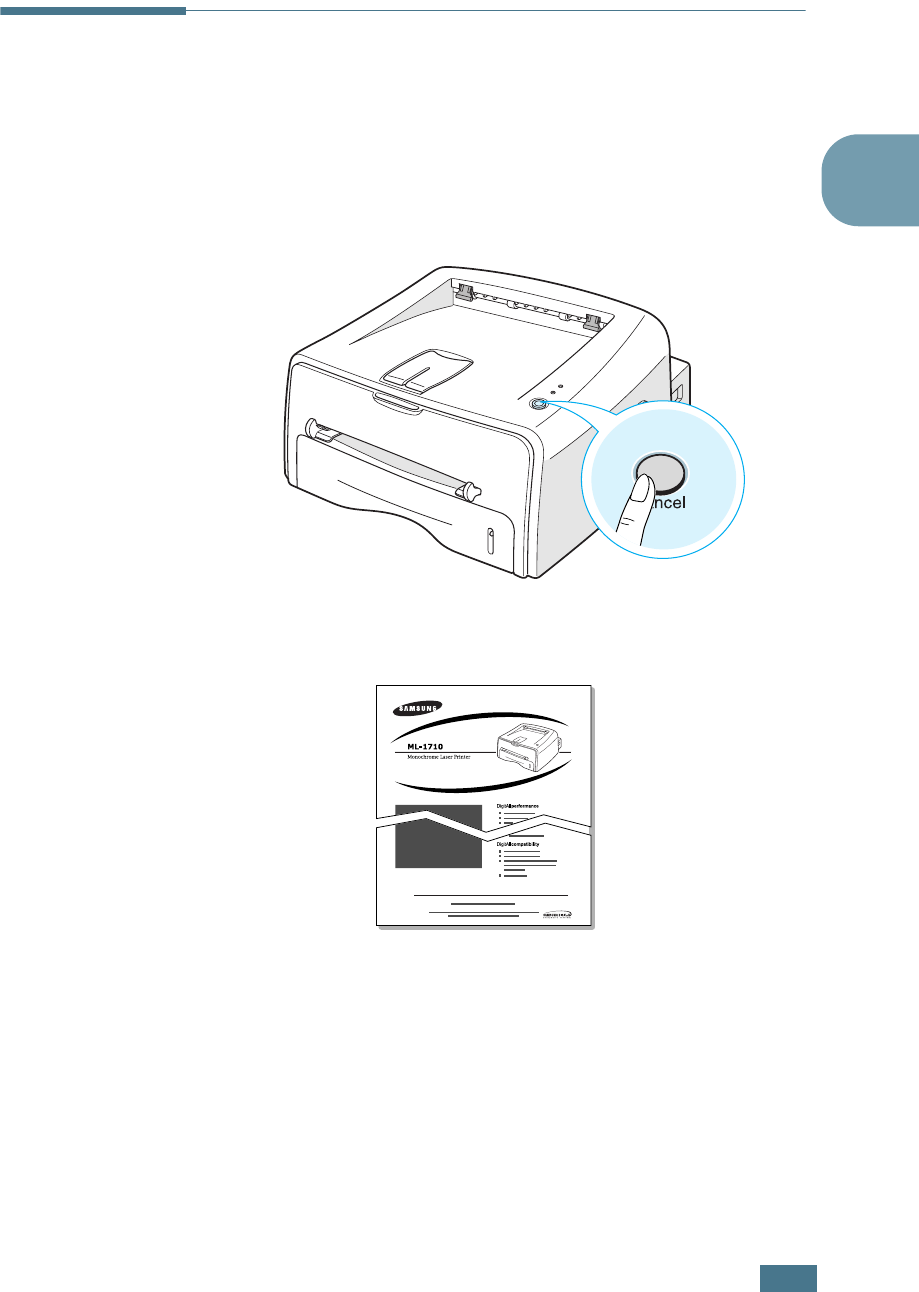
S
ETTING
U
P
Y
OUR
P
RINTER
2.11
2
Printing a Demo Page
Print a demo page to make sure that the printer is operating
correctly.
1
Hold down the Cancel button for about 2 seconds to print a
demo page.
2
The Demo page shows the printer’s current configuration.

S
ETTING
U
P
Y
OUR
P
RINTER
2.12
Installing Printer Software
The supplied CD-ROM contains Windows printing software,
Macintosh printing software, Linux printing software, on-line
User’s Guide and Acrobat Reader to view the User’s Guide.
If you are printing from Windows
You can install the following printer software using the CD-ROM.
• SPL printer driver for windows. Use this driver to take full
advantage of your printer’s features. See page 2.14.
• Status Monitor allows you to see the printing status of the
printer. See page 4.26.
• USB driver for adding the USB port to Windows 98/Me. You
must first install the USB driver for the USB connection in
Windows 98/Me. In Windows 2000/XP, the USB port is
provided, so that you don’t have to install the USB driver.
If you are printing from Macintosh
Go to “Using Your Printer with a Macintosh” on page 7.2, for
information about installing the print software and printing from
a Macintosh.
If you are printing in Linux
Go to “Using Your Printer in Linux” on page 7.10, for information
about installing the Linux driver.
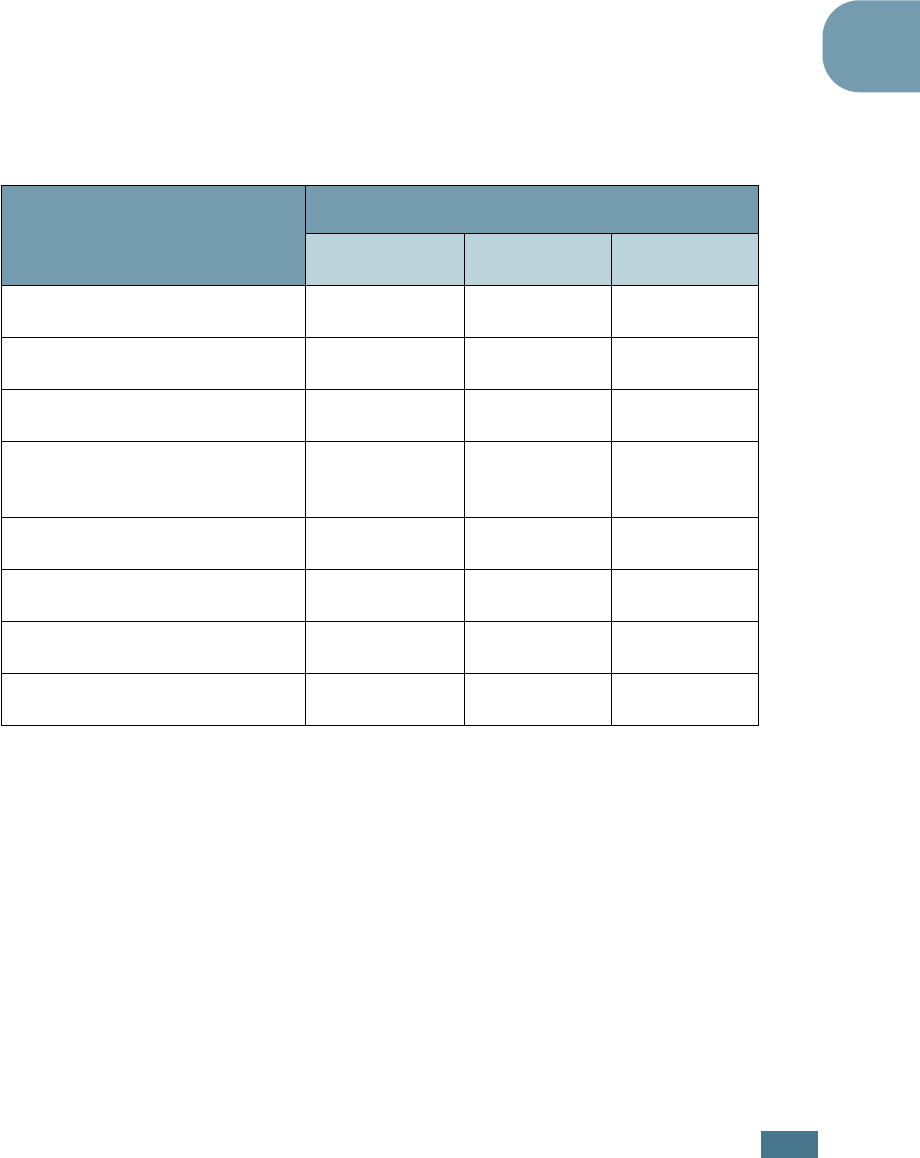
S
ETTING
U
P
Y
OUR
P
RINTER
2.13
2
Printer Driver Features
The your printer drivers will support the following standard
features:
• Paper source selection
• Paper size, orientation and media type
• number of copies
Table below lists a general overview of features supported by the
your printer drivers.
Feature
SPL
Win98/Me Win2000/XP Macintosh
Toner Save Y Y N
Print quality option Y Y Y
Poster printing Y Y N
Multiple pages per sheet
(N-up) YYY
Fit to page printing Y Y N
Scale printing Y Y Y
Watermark Y Y Y
Overlay Y Y N

S
ETTING
U
P
Y
OUR
P
RINTER
2.14
Installing Printer software in Windows
System Requirements
Verify the following:
• At least 32 MB (Windows 98/Me), 64 MB (Windows 2000),
128 MB (Windows XP) or more of RAM is installed on your PC.
• There is at least 200 MB (Windows 98/Me), 650 MB
(Windows 2000), 1.5 GB (Windows XP) of free disk space on
your PC.
• All applications are closed on your PC before beginning
installation.
• Windows 98, Windows Me, Windows 2000 or Windows XP.
In Windows 2000/XP
1
Place the CD-ROM in the CD-ROM drive. Installation will
start automatically.
If the CD-ROM drive does not automatically run:
Select Run from the Start menu, and type
x:\cdsetup.exe in the Open box (where x is the drive
letter for the CD-ROM drive), then click OK.
Note: If the New Hardware Found window appears during the
installation procedure, click in the upper right coner of the box,
or click Cancel.
2
When the language selection window appears, select the
appropriate language.
If you can’t find the desired language from the screen,
scroll through the screen using the scroll button on the
bottom right of the screen.

S
ETTING
U
P
Y
OUR
P
RINTER
2.15
2
3
Click Install the Samsung Software I on your PC (SPL
Driver) or Install the Samsung Software II on your PC
(Status Monitor).
4
The Welcome window opens. Click Next.
5
Follow the instructions on the window to complete the
installation.
In Windows 98/Me
1
Connect the printer to your computer using the USB cable
and turn them on. For detailed information, see page 2.9.
2
The Add New Hardware Wizard window appears. Click
Next.
3
Place the CD-ROM in the CD-ROM drive and check Search
for the best driver for your device and click Next.

S
ETTING
U
P
Y
OUR
P
RINTER
2.16
4
Check CD-ROM drive and click Browse, and choose
x:\USB (where x is the drive letter for the CD-ROM drive).
Click Next.
5
Click Next. The USB driver will be installed.
6
When the installation is completed, click Finish.
7
When the opening window appears, select the appropriate
language.
Note: If you already installed the printer software, this screen
doesn’t appear.
8
Follow the instructions on the window to complete the
printer software installation. For more details, see
page 2.14.
Notes: If your printer doesn’t work properly, reinstall the printer
driver.

S
ETTING
U
P
Y
OUR
P
RINTER
2.17
2
Reinstalling Printer software
Reinstall is required if your installation fails.
1
From the Start menu, select Programs.
2
Select Samsung ML-1710 Series, and then Samsung
ML-1710 Series Driver Maintenence .
3
The Samsung ML-1710 Series Driver Maintenance window
appears. Click Repair and then click Next.
4
When reinstallation is done, click Finish.
Removing Printer software
1
From the Start menu, select Programs.
2
Select Samsung ML-1710 Series, and then Samsung
ML-1710 Series Driver Maintenence .
3
The Samsung ML-1710 Series Driver Maintenance window
appears. Check Remove and then click Next.
4
When you are asked to confirm your selection, click OK.
The Samsung ML-1710 Series printer driver and all of its
components are removed from your computer.
5
When removing is completed, click Finish.

S
ETTING
U
P
Y
OUR
P
RINTER
2.18
Changing the Display Language
After installation of the software, you can change the display
language. If you installed the Status Monitor, the selected
language is applied to it.
1
From the Start menu, select Programs.
2
Select Samsung ML-1710 Series, and Language
Selection.
3
Select the desired language from the language selection
window, and click OK.
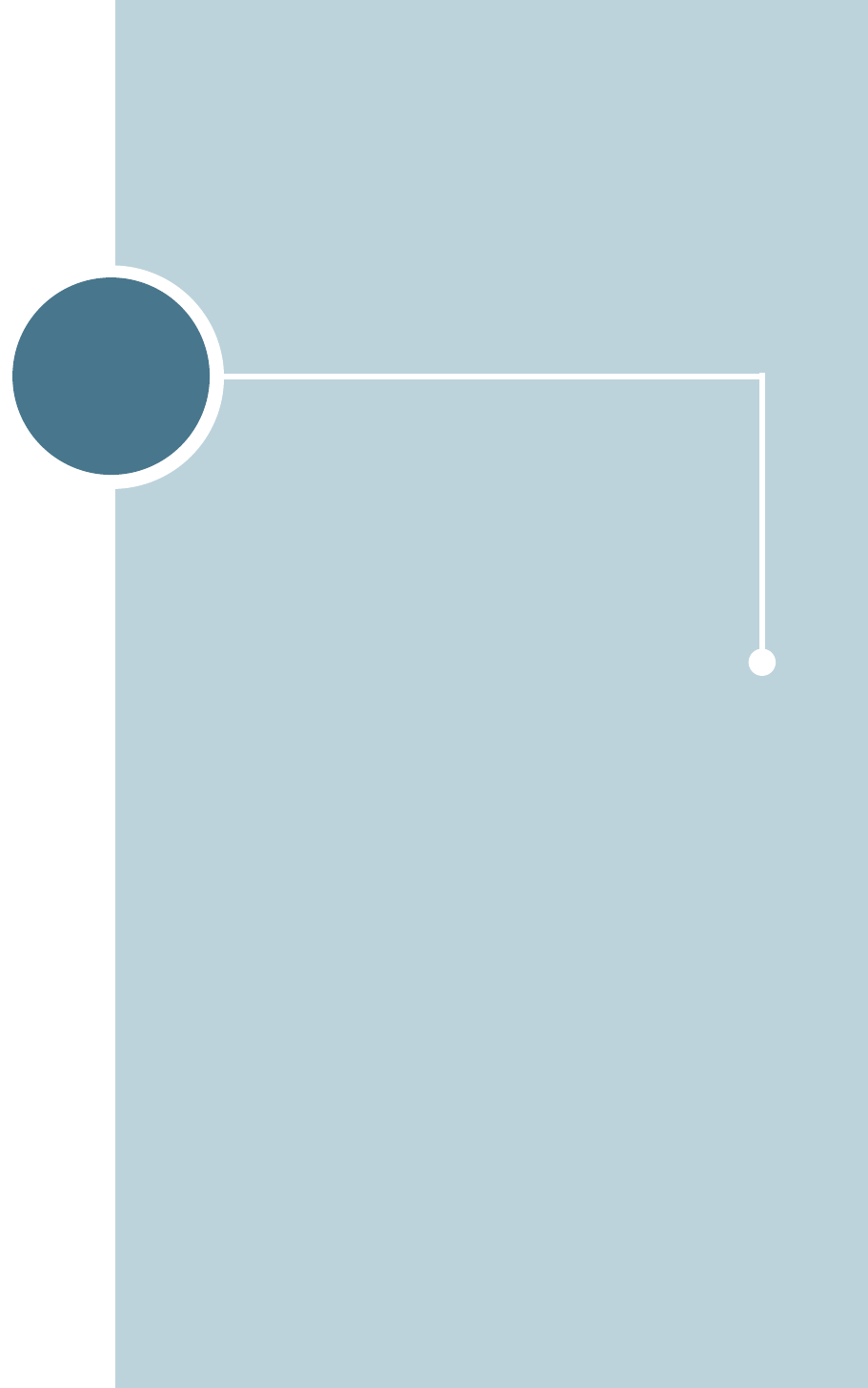
3
This chapter will help you understand types of paper you
can use with this printer and how to properly load paper in
the tray for the best print quality.
This chapter includes:
• Choosing Paper and Other Materials
• Selecting the Output Location
• Loading Paper
• Printing on Envelopes
• Printing on Labels
• Printing on Transparencies
• Printing on Card Stock or Custom-sized Materials
Using Print Materials

U
SING
P
RINT
M
ATERIALS
3.2
Choosing Paper and Other Materials
You can print on a variety of print materials, such as plain paper,
envelopes, labels, transparencies and so on. See “Paper
Specifications” on page 7.21. To get the best possible print
quality, use only high-quality copier-grade paper.
When you choose print materials, consider the followings:
• Desired outcome: The paper you choose should be
appropriate for the project.
• Size: You can use any size paper that fits easily within the
paper adjusters of the paper feeder.
• Weight: Your printer supports paper weight as follows:
• 16~24 lbs (60~90 g/m
2
) bond for the tray
• 16~43 lbs (60~163 g/m
2
) bond for the manual feeder
• Brightness: Some papers are whiter than others and produce
sharper, more vibrant images.
• Surface smoothness: The smoothness of the paper affects
how crisp the printing looks on the paper.
CAUTION: Using a material that does not conform to the
specification listed in the paper specification can cause problems
that may require service. This service is not covered by the
warranty or service agreements.

U
SING
P
RINT
M
ATERIALS
3.3
3
Sizes and Capacities
Size
Input Source/Capacity
a
a. Depending on paper thickness, the maximum capacity may be reduced.
Tray Manual Feeder
Plain Paper
Letter (8.5 x 11 in.)
Legal (8.5 x 14 in.)
Executive (7.25 x 10.5 in.)
Folio (8.5 x 13 in.)
A4 (210 x 297 mm)
B5 (182 x 257 mm)
A5 (148 x 210 mm)
A6 (105 x 148 mm)
250
250
250
250
250
250
250
250
1
1
1
1
1
1
1
1
Envelopes
b
No. 10 (4.12 x 9.5 in.)
Monarch (3.87 x 7.5 in.)
C5 (162 x 229 mm)
DL (110 x 220 mm)
B5 (176 x 250 mm)
C6 (114 x 162 mm)
b. If you are experiencing excessive jamming, feed one sheet at a time through the
manual feeder.
-
-
-
-
-
-
1
1
1
1
1
1
Labels
b
Letter (8.5 x 11 in.)
A4 (210 x 297 mm)
-
-
1
1
Transparencies
b
Letter (8.5 x 11 in.)
A4 (210 x 297 mm)
-
-
1
1
Card stocks
b
-1

U
SING
P
RINT
M
ATERIALS
3.4
Guidelines for Paper and Special Materials
When selecting or loading paper, envelopes, or other special
materials, keep these guidelines in mind:
• Attempting to print on damp, curled, wrinkled, or torn paper
can cause paper jams and poor print quality.
• Use cut-sheet paper only. You cannot use multi-part paper.
• Use only high-quality, copier grade paper for the best print
quality.
• Do not use paper that has been already printed on or that has
been fed through a photocopier.
• Do not use paper with irregularities, such as tabs or staples.
• Do not attempt to load any feeder during printing and never
overfill the feeder. This could cause a paper jam.
• Avoid paper with embossed lettering, perforations, or texture
that is too smooth or too rough.
• Colored paper should be of the same high quality as white
photocopy paper. The pigments must withstand the printer’s
fusing temperature of 400°F (205°C) for 0.1 second without
deterioration. Do not use paper with a colored coating that was
added after the paper was produced.
• Preprinted forms must be printed with nonflammable, heat-
resistant ink that do not melt, vaporize, or release hazardous
emissions when subject to the printer’s approximately 400°F
(205°C) fusing temperature for 0.1 second.
• Store paper in its ream wrapper until ready to use. Place
cartons on pallets or shelves, not on the floor.
• Do not place heavy objects on top of the paper, whether it is
packaged or unpackaged.
• Keep paper away from moisture, direct sunlight or other
conditions that can cause it to wrinkle or curl.
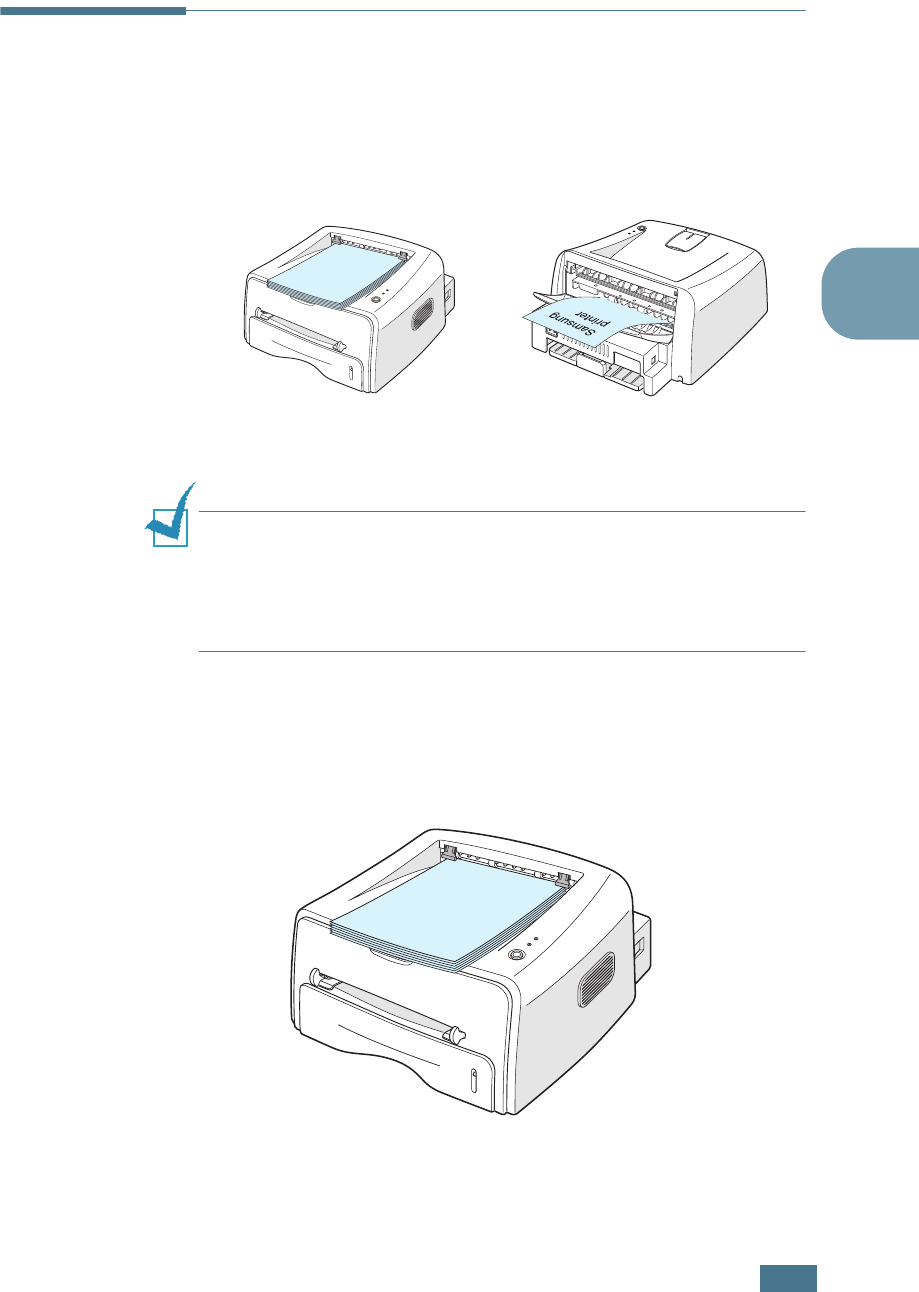
U
SING
P
RINT
M
ATERIALS
3.5
3
Selecting the Output Location
The printer has two output locations: the rear output tray and
the top output tray.
To use the top output tray, be sure the rear output tray is closed.
To use the rear output tray, open it.
Notes:
• If paper coming out of the top output tray has problems, such as
excessive curl, try printing to the rear output tray.
• To avoid paper jams, do not open or close the rear output tray
while the printer is printing.
Printing to the Top Output Tray
(Face down)
The top output tray collects paper face-down, in correct order.
The top output tray should be used for most print jobs.
❷ Top output tray ❷ Rear output tray

U
SING
P
RINT
M
ATERIALS
3.6
Printing to the Rear Output Tray
(Face up)
The printer always prints to the rear output tray if it is open.
Paper comes out of the printer face-up, and each time a sheet
of paper comes out, it falls down from the printer.
Printing from the Manual Feeder to the rear output tray provides
the straight paper path. Opening the rear output tray might
improve the output quality with the following:
• envelopes
• labels
• transparencies
To open the rear output tray:
1
Open the rear door by pulling it down. The cover functions
as the output tray.
Notes: Please be careful when you open the rear cover. The inside
of the printer is still hot.
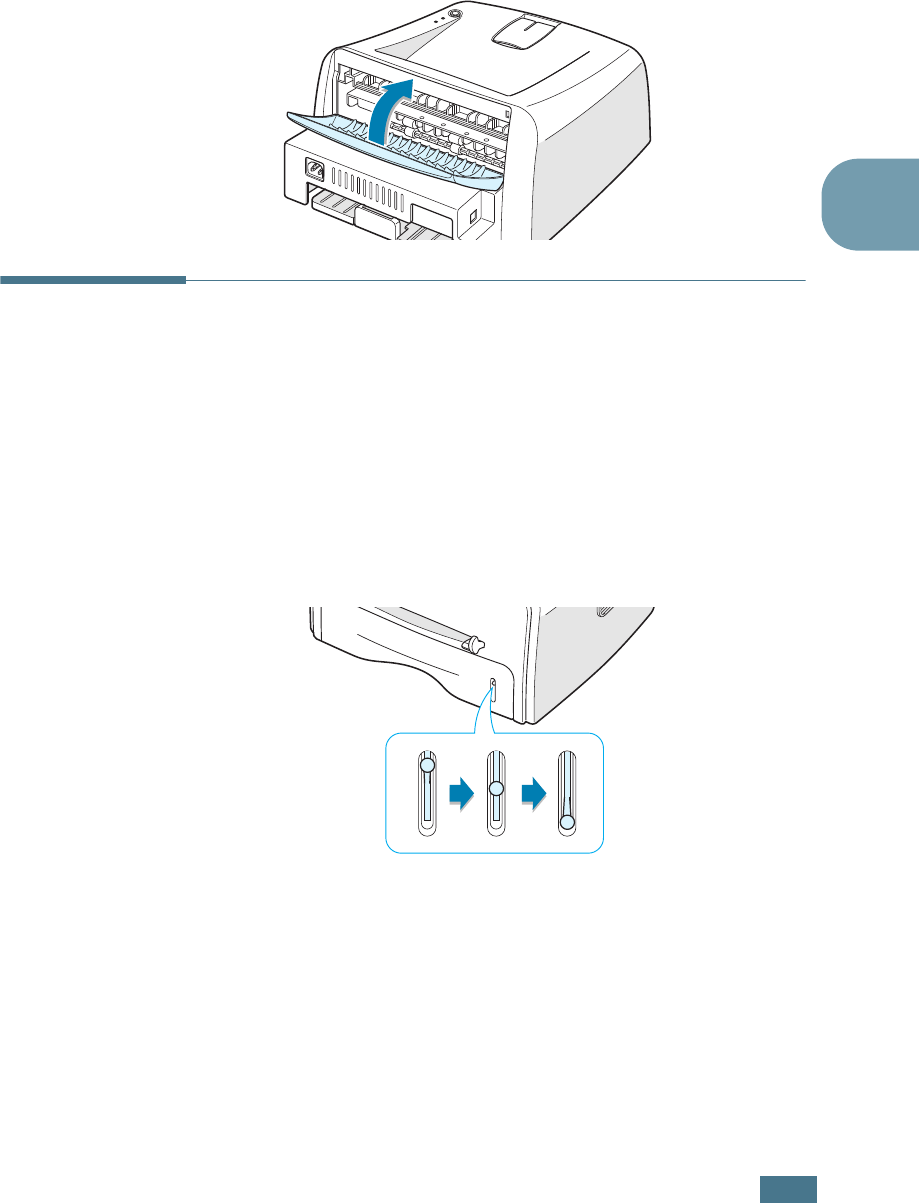
U
SING
P
RINT
M
ATERIALS
3.7
3
2
If you do not want to stack the printed pages on the rear
output tray close the tray. The pages will stack on the top
output tray.
Loading Paper
Proper paper loading helps prevent paper jams and ensure
trouble-free printing. Do not remove the tray while a job is
printing. Doing so may cause a paper jam. See “Sizes and
Capacities” on page 3.3 for acceptable paper size and capacities
for each tray.
The paper level bar on the front of the paper tray shows the
amount of paper currently right in the tray. When the tray is
empty, the indicator of the bar is lowered.
Using the Tray
The tray holds 250 sheets of paper. See “Sizes and Capacities”
on page 3.3 for acceptable paper size and capacities of each
tray.
Load a stack of paper into the tray and print. for details about
loading paper in the tray, see “Loading Paper” on page 2.6.
Paper full ➐➐☎Paper empty
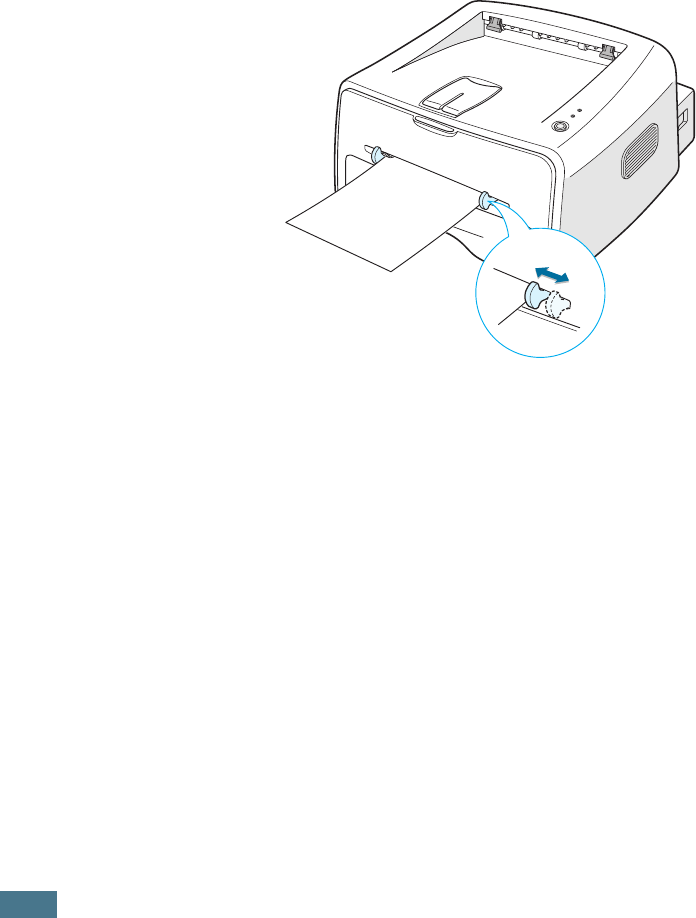
U
SING
P
RINT
M
ATERIALS
3.8
Using the Manual Feeder
If you select Manual Feed in the Source option, you can
manually load paper in the manual feeder. Manually loading
paper can be helpful when you want to check the print quality
after each page is printed.
If you experience a paper jam from the tray, load one sheet of
paper at a time into the manual feeder.
1
Load the print material in the manual feeder with the print
side up.
Adjust the paper guide against the print material without
bending the paper.
2
When you print a document, you must select Manual Feed
for Source from the software application, and then select
the correct paper size and type. For details, see page 4.6.
3
Press the Cancel button to start feeding.
4
Printing is started.
5
If you are printing multiple pages, load the next sheet after
the first page prints out, and press the Cancel button.
Repeat this step for every page to be printed.
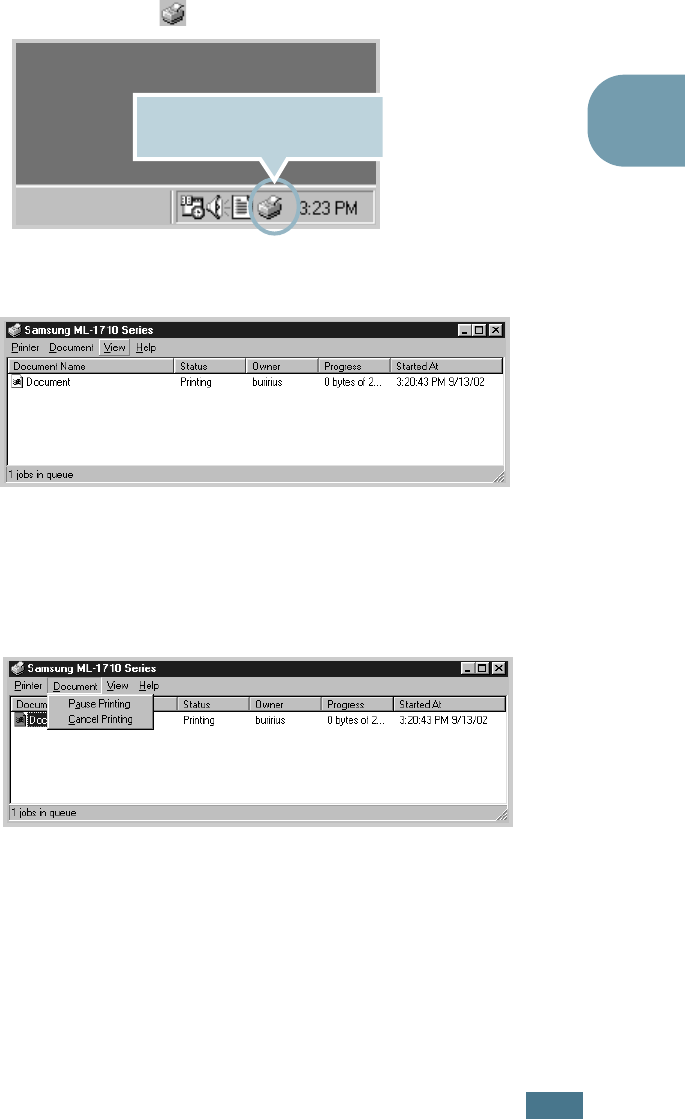
U
SING
P
RINT
M
ATERIALS
3.9
3
In Manual Feed mode, you can’t cancel a print job by pressing
the Cancel button.
To cancel a print job in Manual Feed mode:
1
Turn the printer off.
2
Double-click the icon at right bottom of the window.
3
Select a job you want to cancel.
4
For Windows 98/Me, select Cancel Printing from
Document menu.
For Windows 2000/XP, select Cancel from Document
menu.
5
When the jobs are removed from the list. Turn the printer
on.
Double-click this icon to view
the queue of the print jobs.
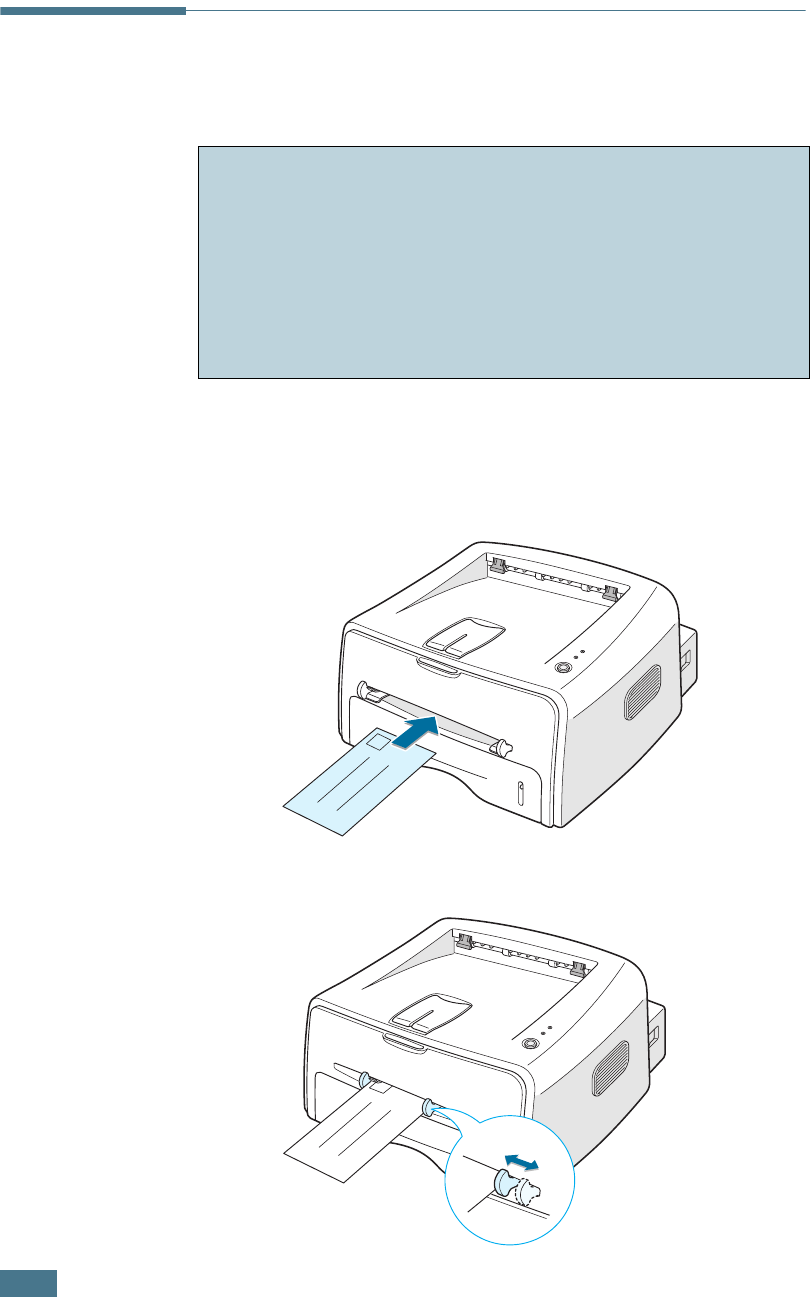
U
SING
P
RINT
M
ATERIALS
3.10
Printing on Envelopes
1
Open the rear output tray. Load the envelopes into the
manual feeder with the flap side down.
The stamp area is on the left side and the end of the
envelope with the stamp area enters the feeder first.
2
Adjust the guide to the edge of the envelope stack.
Guidelines
• Only use envelopes recommended for laser printers. Before
loading envelopes in the manual feeder, make sure that they
are undamaged and are not stuck together.
• Do not feed stamped envelopes.
• Never use envelopes with clasps, snaps, windows, coated
lining, or self-stick adhesives. These envelopes may severely
damage the printer.
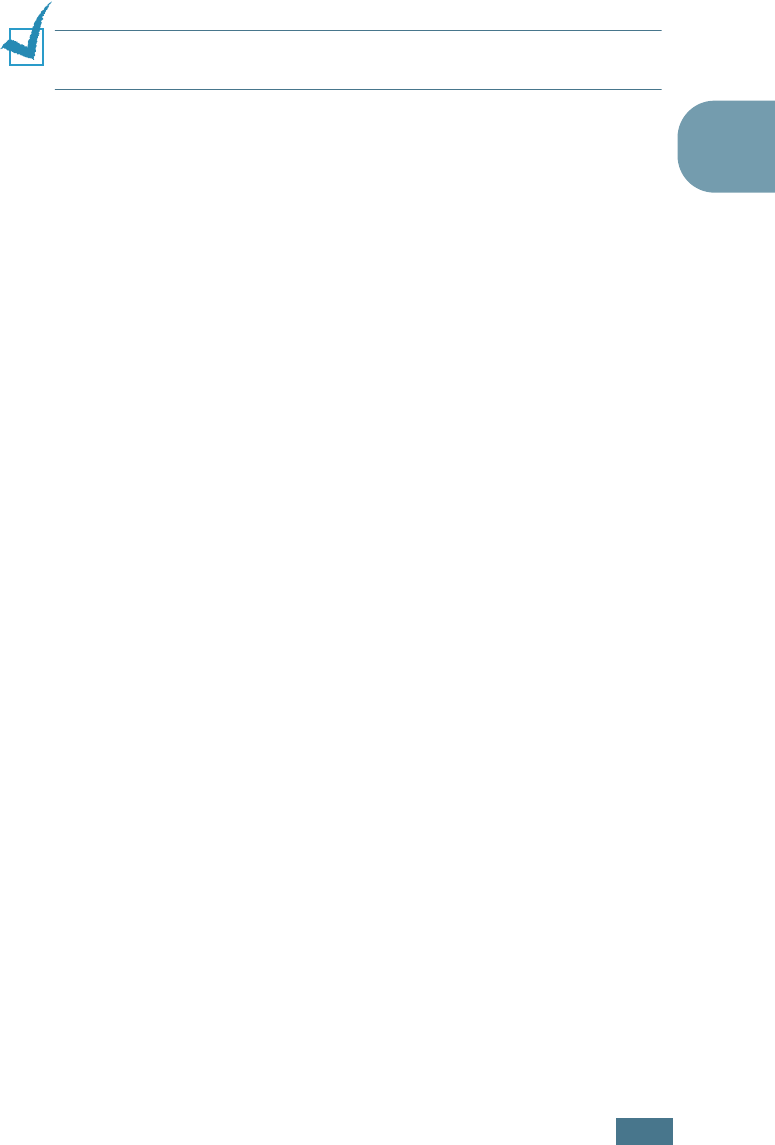
U
SING
P
RINT
M
ATERIALS
3.11
3
3
When you print on envelopes, you must select Manual
Feed for Source from the software application, and then
select the correct paper size and type. For details, see
page 4.6.
4
Press the Cancel button to start feeding.
Notes: Please be careful when you open the rear cover. The inside
of the printer is still hot.
5
Printing is started. Close the rear output tray.
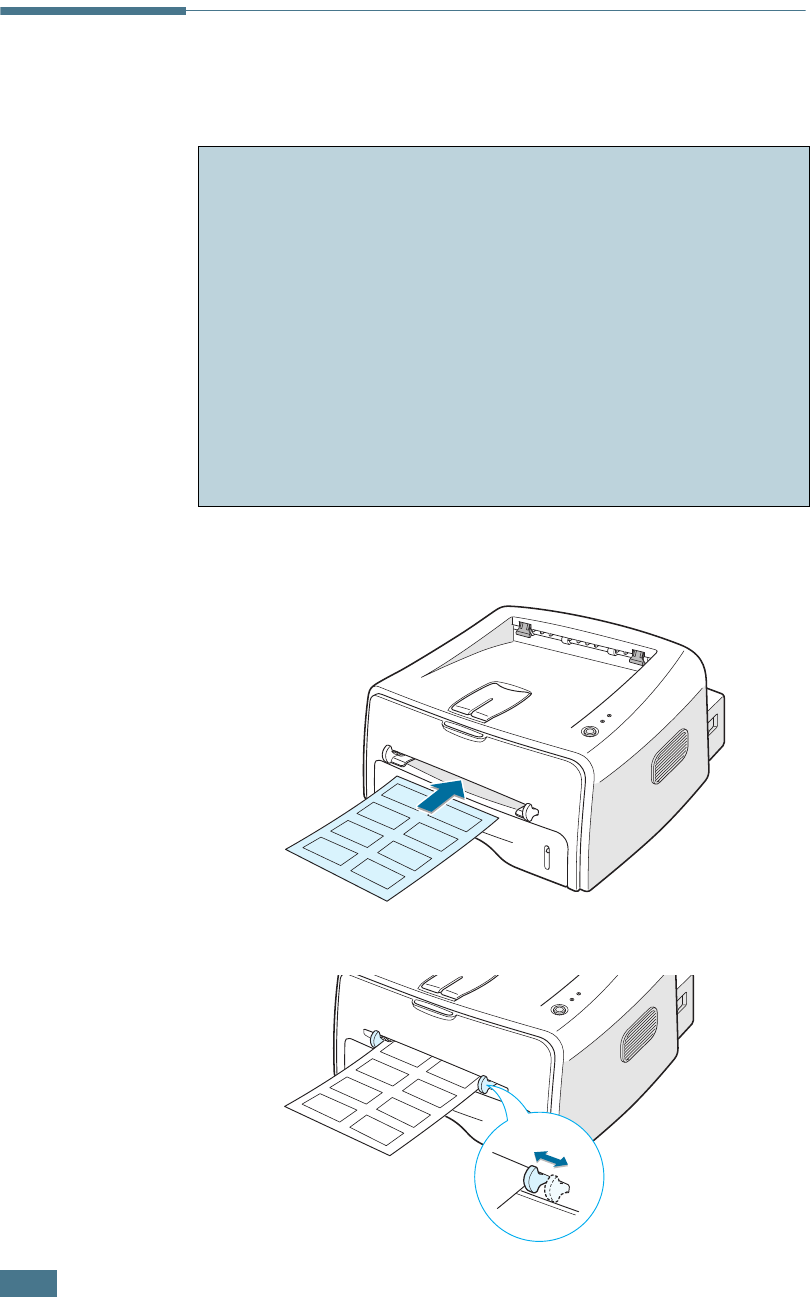
U
SING
P
RINT
M
ATERIALS
3.12
Printing on Labels
1
Open the rear output tray. Load labels in the manual feeder
with print side up.
2
Adjust the guide to fit the width of the labels.
Guidelines
• Only use labels recommended for laser printers.
• Verify that the labels’ adhesive material can tolerate fusing
temperature of 200°C (392°F) for 0.1 second.
• Make sure that there is no exposed adhesive material
between the labels. Exposed areas can cause labels to peel
off during printing, which can cause paper jams. Exposed
adhesive can also cause damage to printer components.
• Do not feed a sheet of label through the printer more than
once. The adhesive backing is designed for one pass through
the printer.
• Do not use labels that are separating from the backing sheet
or are wrinkled, bubbled, or otherwise damaged.

U
SING
P
RINT
M
ATERIALS
3.13
3
3
When you print on labels, you must select Manual Feed for
Source from the software application, and then select the
correct paper size and type. For details, see page 4.6.
Notes: Please be careful when you open the rear cover. The inside
of the printer is still hot.
4
Press the Cancel button to start feeding. Printing is started.
Close the rear output tray.
Note: To prevent labels from sticking, do not let the printed label
sheets stack up as they are printed out.
Printing on Transparencies
1
Open the rear output tray. Load transparencies in the
manual feeder with print side up, and the top with the
adhesive strip going first.
Guidelines
• Only use transparencies recommended for use in laser
printers.
• Ensure that transparencies are not wrinkled, curled, or have
any torn edges.
• Hold the transparencies by the edges and avoid touching the
print side. Oils deposited on the transparency can cause print
quality problems.
• Be careful not to scratch or leave fingerprints on the print
side.
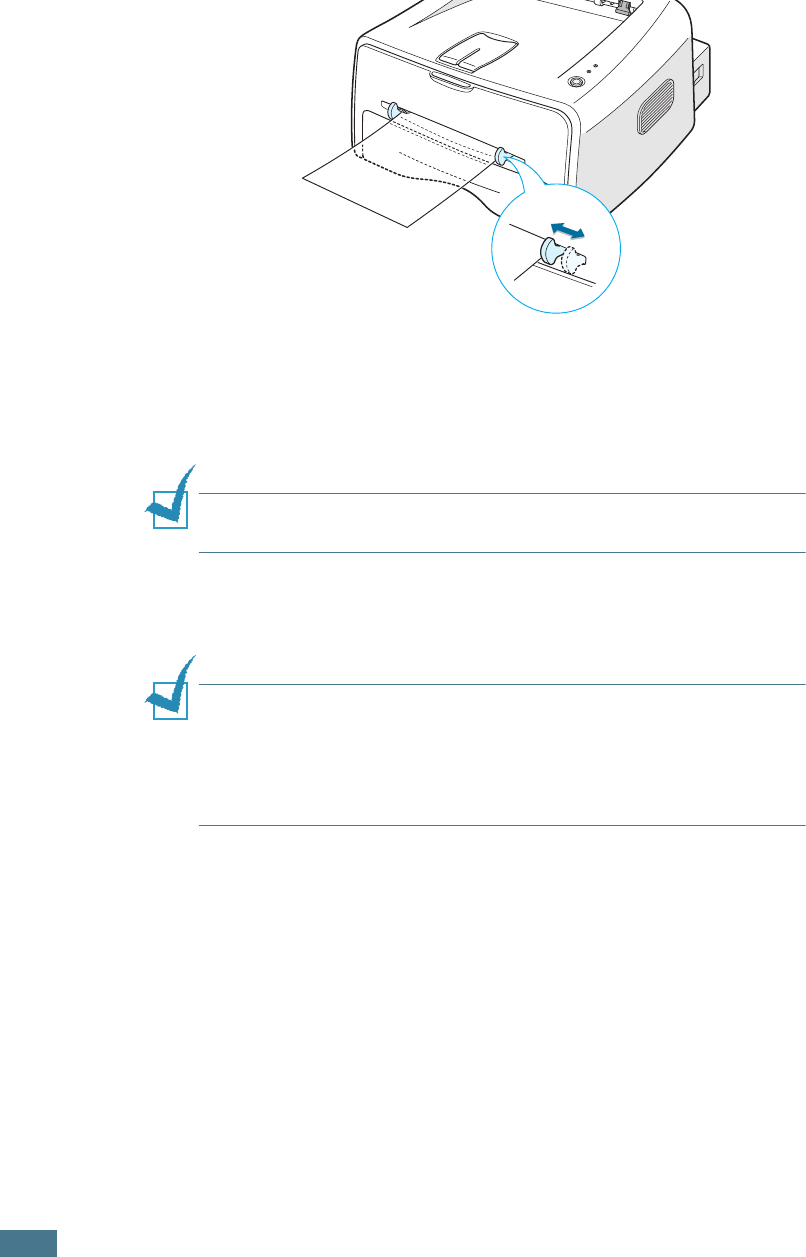
U
SING
P
RINT
M
ATERIALS
3.14
2
Adjust the guide to fit the width of the transparencies.
3
When you print on transparencies, you must select Manual
Feed for Source from the software application, and then
select the correct paper size and type. For details, see
page 4.6.
Notes: Please be careful when you open the rear cover. The inside
of the printer is still hot.
4
Press the Cancel button to start feeding.
Printing is started. Close the rear output tray.
Notes:
• To prevent transparencies from sticking, do not let the printed
sheets stack up as they are printed out.
• Place transparencies on a flat surface after removing them from
the printer.

U
SING
P
RINT
M
ATERIALS
3.15
3
Printing on Card Stock or
Custom-sized Materials
Postcards, 3.5 by 5.83 in.(index) cards and other custom-sized
materials can be printed with this printer. The minimum size is
76 by 127mm(3.0 by 5.0 in.) and the maximum size is 216 by
356mm(8.5 by 14 in.).
1
Open the rear output tray. Load print material with print
side up, short edge first and against the left edge of the
feeder.
2
Adjust the guide to fit the width of the material.
Guidelines
• Always insert the short-edge into the Manual Feeder first. If
you want to print in landscape mode, make this selection
through your software. Inserting paper long-edge first may
cause a paper jam.
• Do not print on media smaller than 76mm (3.0 in.) wide or
127mm(5.0 in.) long.
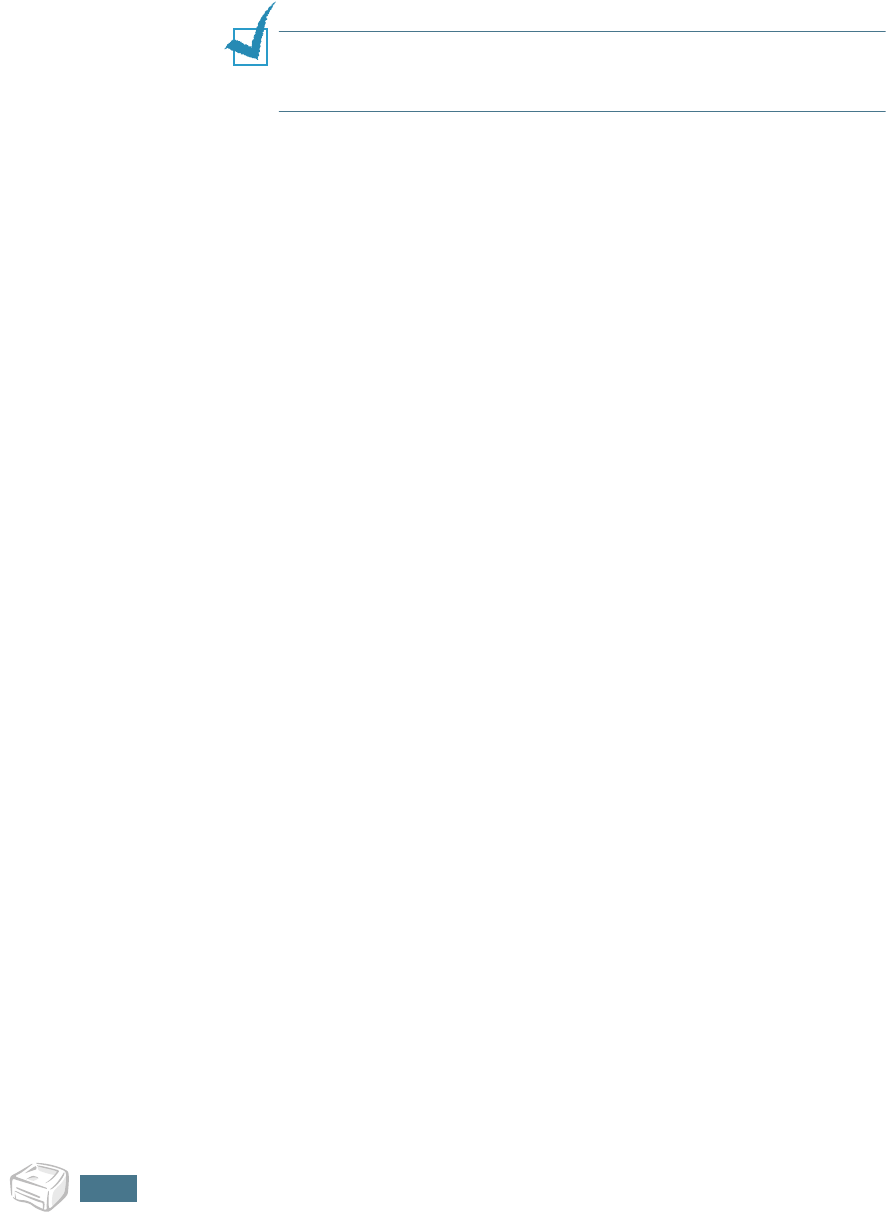
U
SING
P
RINT
M
ATERIALS
3.16
3
When you print on card stocks or the custom-sized paper,
you must select Manual Feed for Source from the
software application, and then select the correct paper size
and type. For details, see page 4.6.
Note: If the size of your print material is not listed in the Size box
in the Paper tab of the printer driver properties, click Add
Custom button and set the size manually. See page 4.6.
4
Press the Cancel button to start feeding.
Printing is started. Close the rear output tray.
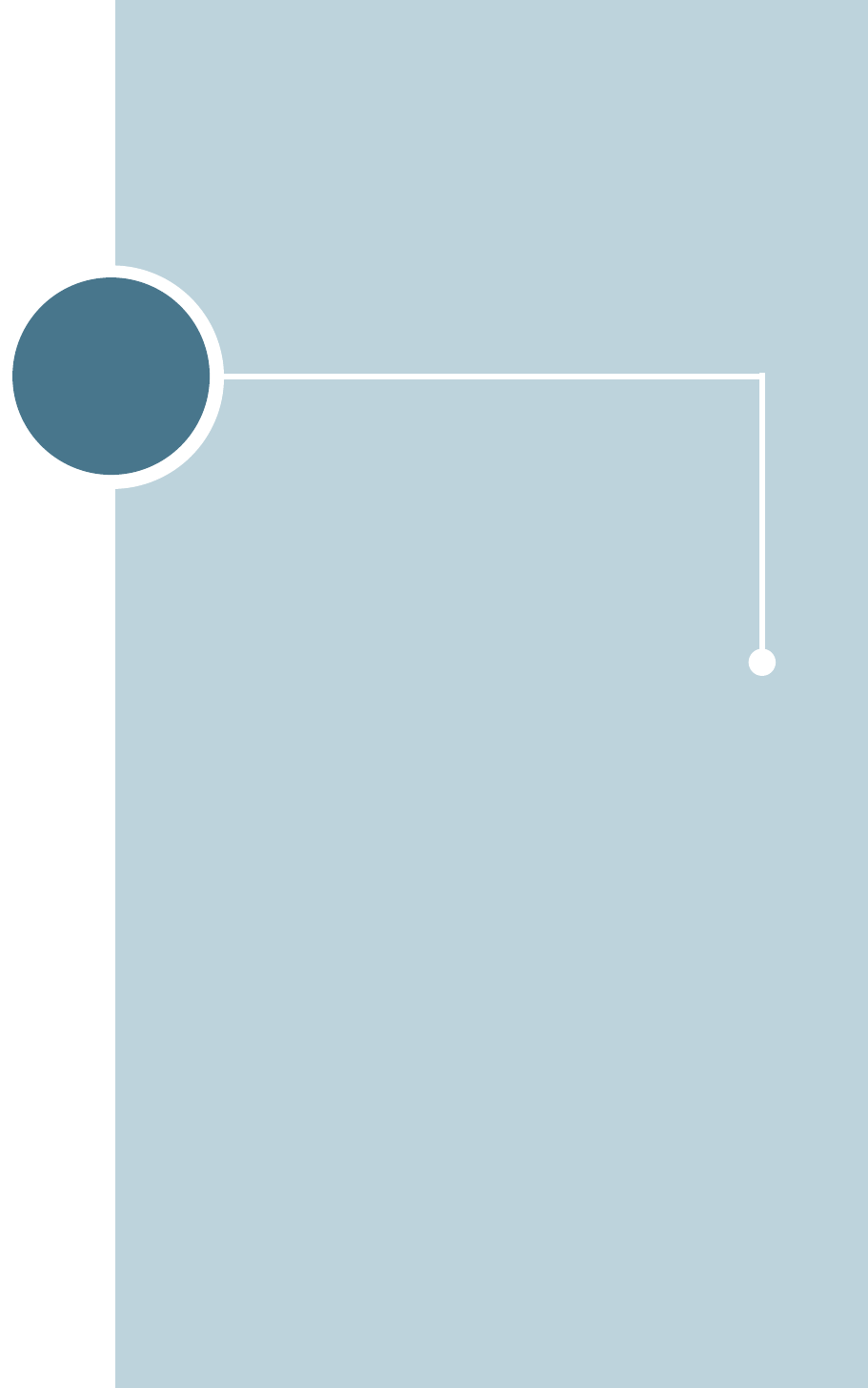
4
This chapter explains the printing options and common
printing tasks.
This chapter includes:
• Printing a Document
• Setting Paper Properties
• Using the Toner Save Mode
• Printing Multiple Pages on One Sheet of Paper
(N-Up Printing)
• Scaling Your Document
• Fitting Your Document to a Selected Paper Size
• Printing Posters
• Setting Graphic Properties
• Printing Watermarks
• Printing Overlays
• Using the Status Monitor
• Setting Up Locally Shared Printer
Printing Tasks
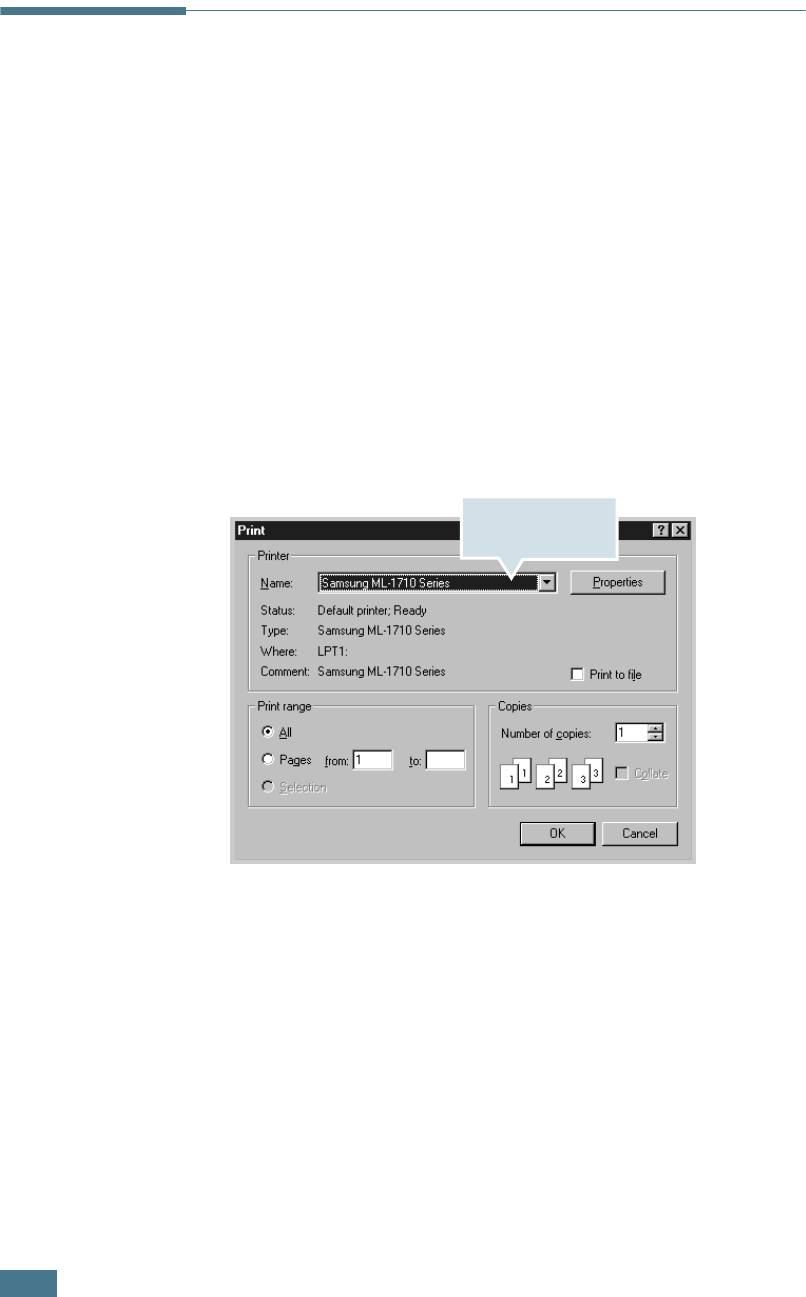
P
RINTING
T
ASKS
4.2
Printing a Document
The following procedure describes the general steps required for
printing from various Windows applications. The exact steps for
printing a document may vary depending on the application
program you are using. Refer to the User’s Guide of your
software application for the exact printing procedure.
1
Open the document you want to print.
2
Select Print from the File menu. The Print window is
displayed (It may look slightly different depending on your
application).
The basic print settings are selected within the Print
window. These settings include the number of copies and
print range.
3
To take advantage of the printer features provided by your
printer, click Properties in the application’s print window
and go to step 4.
If you see Setup, Printer, or Options, click that button
instead. Then click Properties in the next screen.
Make sure that your
printer is selected.
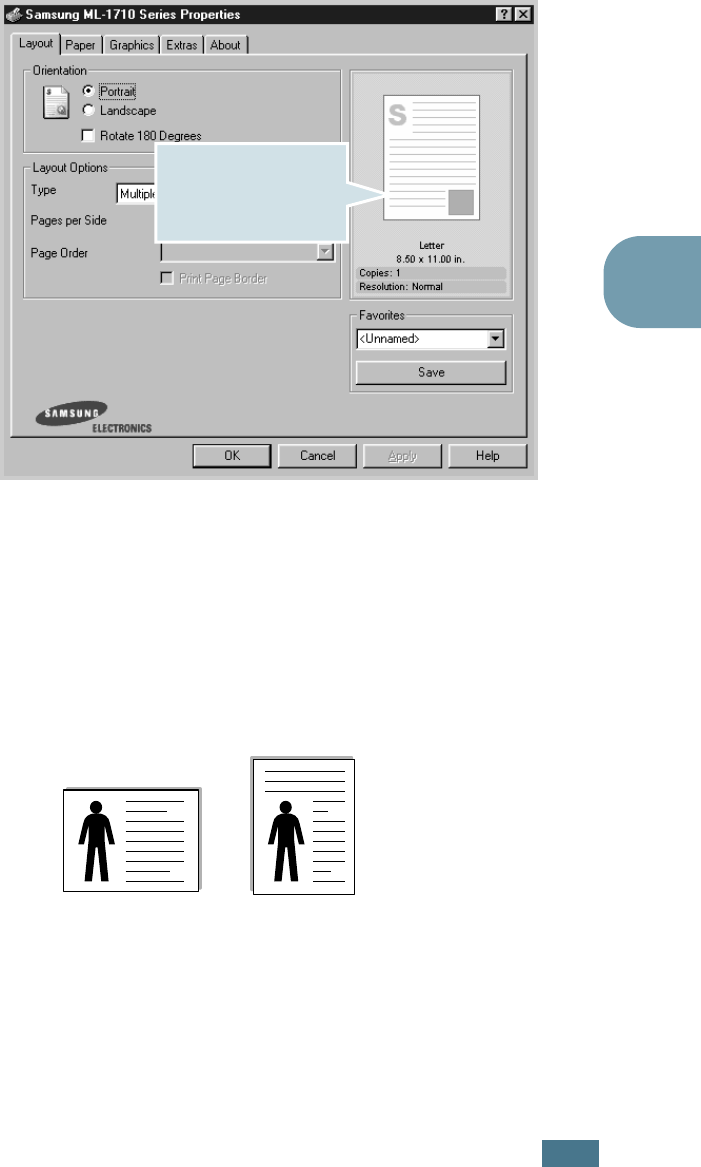
P
RINTING
T
ASKS
4.3
4
4
Now you see the Samsung ML-1710 series Properties
window, which allows you to access all the information you
will need when using your printer.
The Layout tab is first displayed.
If necessary, select the Orientation option.
The
Orientation
option allows you to select the direction in
which information is printed on a page.
•Portrait
prints across the width of the page, letter style.
•Landscape
prints across the length of the page, spreadsheet
style.
•
If you want to rotate the page in 180 degrees, select
Rotate
180 Degrees
.
5
From the Paper tab, select the paper source, size and type.
For further details, see page 4.6.
6
Click other tabs on the top of the Samsung ML-1710 series
Properties window to access other features, if needed.
The preview image
shows the sample page
with the settings you
currently specified.
➐ Landscape ➐ Portrait
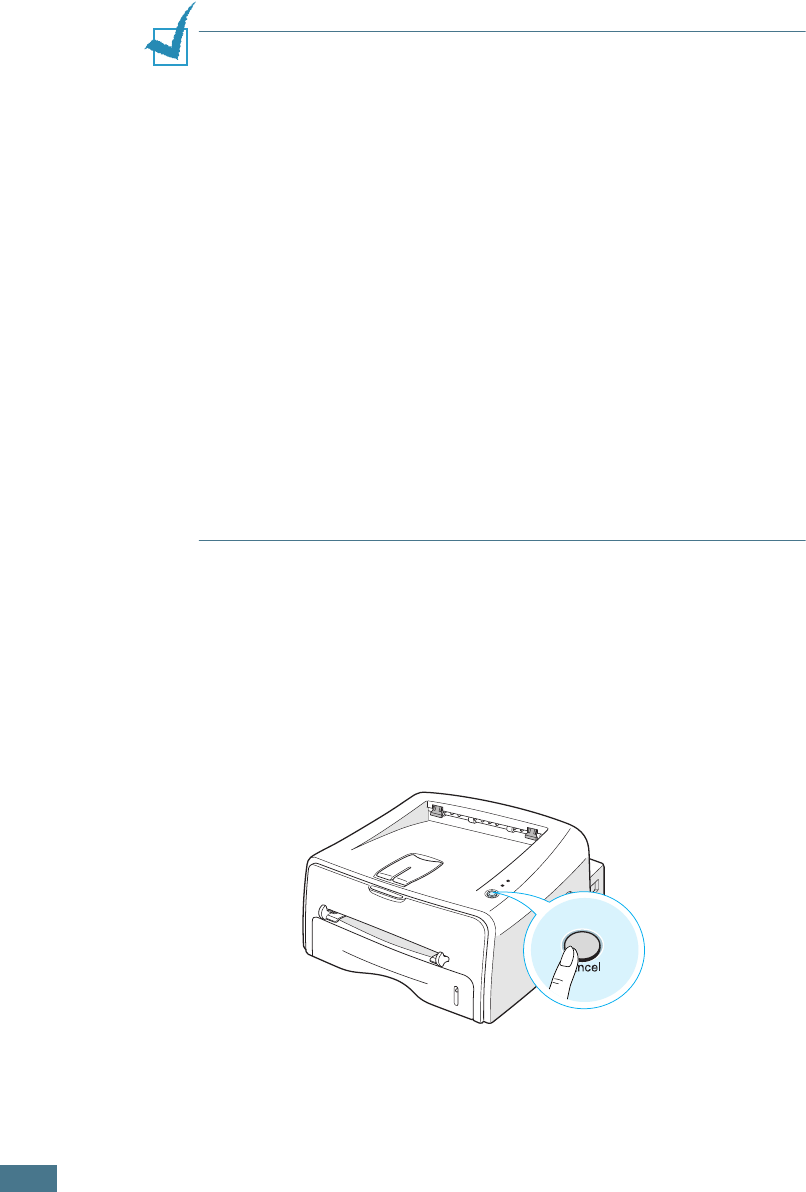
P
RINTING
T
ASKS
4.4
7
When you complete setting the properties, click OK until
the Print window is displayed.
8
Click OK to start printing.
Notes:
• Most Windows applications will override settings you specify in
the printer driver. Change all print settings available in the
software application first, and change any remaining settings
using the printer driver.
• The settings you change remain in effect only while you are
using the current program. To make your changes
permanent, make them in the Printers folder. Follows this
procedure.
1
Click the Windows Start button.
2
For Windows 98/Me/2000, select Settings, and then Printers.
For Windows XP, select Printers and Faxes.
3
Select the Samsung ML-1710 Series printer.
4
Click the right mouse button on the printer icon and:
• In Windows 98/Me, select Properties.
• In Windows 2000/XP, select Printing Preferences.
5
Change the settings on each tab, and click OK.
Canceling a Print Job
There are two ways to cancel a print job.
To stop a print job from the Control Panel
Press the Cancel button on the control panel.

P
RINTING
T
ASKS
4.5
4
The printer will finish printing the page that is moving through
the printer and delete the rest of the print job. Pressing Cancel
cancels only the current job in the printer. If more than one print
job is in the printer memory, Cancel must be pressed once for
each job.
To stop a print job from the Printers folder
1
From the windows Start menu, select Settings.
2
Select Printers to open the Printers window, and double-
click the Samsung ML-1710 Series icon.
3
From the Document menu, select Cancel Printing
(Windows 98/Me) or Cancel (Windows 2000/XP).
Using a Favorite Setting
The Favorites option, which is visible on each properties tab,
allows you to save the current properties settings for future use.
To save a Favorites item:
1
Change the settings as needed on each tab.
2
Enter a name for the item in the Favorites input box.
3
Click Save.
To use a saved setting, just select the item from the Favorites
drop down list.
To delete a favorite setting item, select the desired item from
the list and click Delete.
You can also restore the printer driver’s default settings by
selecting Printer Default from the list.
Using Help
This printer has a help screen that can be activated by the Help
button in the printer’s properties window. These help screen
give detailed information about the printer features provided by
the printer driver.
You can also click from the upper right hand corner, and then
click on any setting.
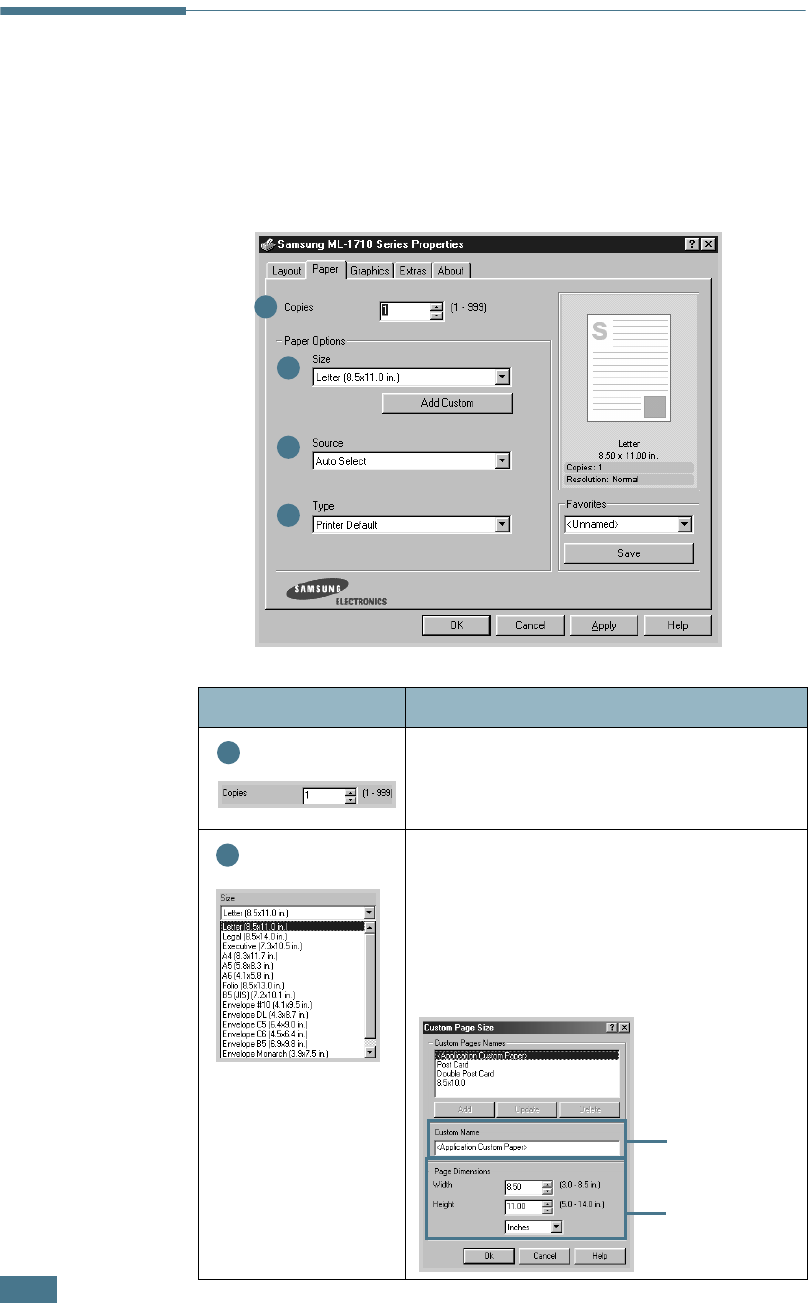
P
RINTING
T
ASKS
4.6
Setting Paper Properties
Use the following options to set the basic paper handling needs
when you access the printer properties. See page 4.2 for more
information on accessing printer properties.
Click the Paper tab to access various paper properties.
Property Description
Copies allows you to choose the number of
copies to be printed. You can enter up to
999.
Size option allows you to choose the size of
paper you loaded into the tray.
If the required size is not listed in the Size
box, click Add Custom
.
When the Custom
Page Size window appears, set the paper
and click OK. The size setting appears in the
size list so that you can select it.
➀
➁
➂
➃
➀
➁
Enter the custom
name you want
to use.
Enter the paper
size.
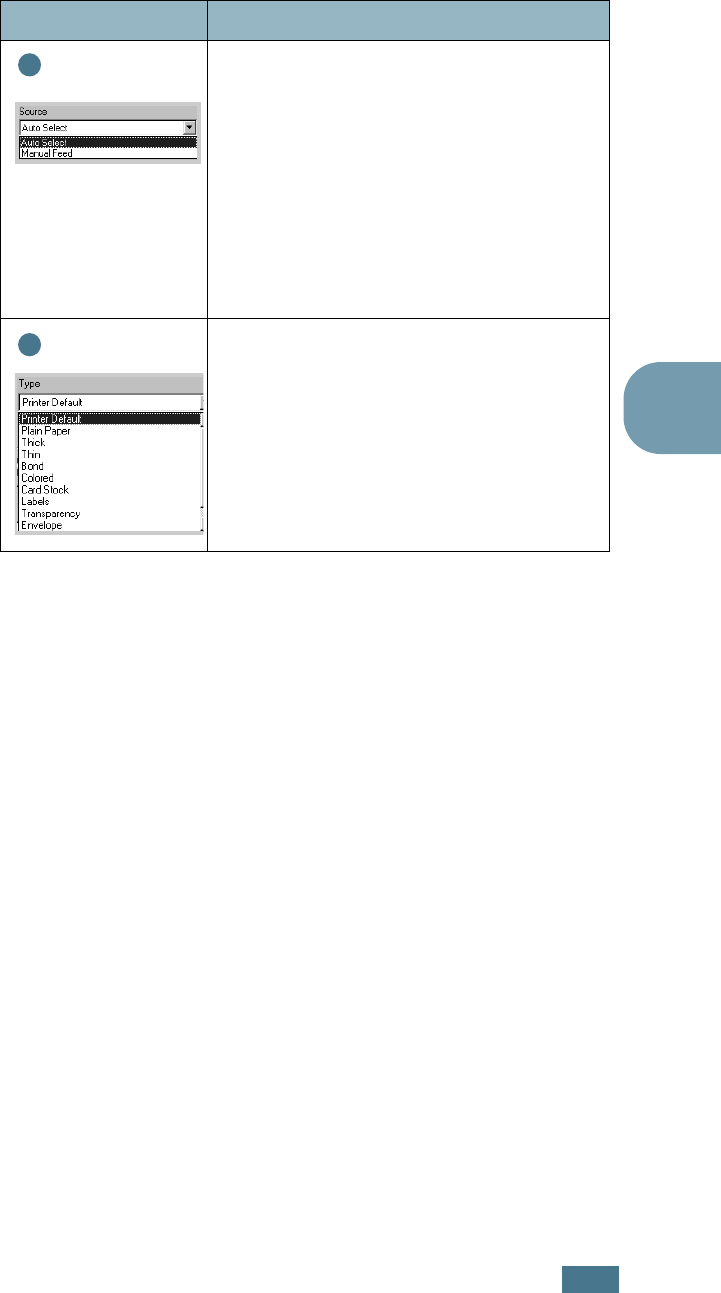
P
RINTING
T
ASKS
4.7
4
Make sure that
Source
is set to the
corresponding paper tray.
Manual Feed source is used when you use
the Manual Feeder to print using special
materials. You have to load one sheet at a
time into the the printer. see page 3.8.
If the paper source is set to Auto Select,
the printer automatically selects paper
from the Manual Feeder first and then from
the Tray.
Make sure the Type is set to Printer
Default. If you load a different type of
print materials, select the corresponding
paper type. For further information on print
materials, refer to chapter 3 "Using Print
Materials".
Property Description
➂
➃

P
RINTING
T
ASKS
4.8
Using the Toner Save Mode
Toner Save mode allows the printer to use less toner on each
page. Selecting this option will extend the life of your toner
cartridge and reduce your cost per page, but will reduce print
quality.
There are two ways to enable the Toner Save mode:
From the Control Panel
Press the Cancel button on the control panel. The printer must
be in Ready mode (On Line/Error green LED is on).
• If the Toner Save LED is on, the mode is enabled and the
printer uses less toner to print a page.
• If the Toner Save LED is off, the mode is disabled and the
printer prints in the normal mode.

P
RINTING
T
ASKS
4.9
4
From the software application
1
When you change the print settings from your software
application, access the printer properties. See page 4.2.
2
Click the Graphics tab, and select the Toner Save option.
You can select from:
•Printer Setting: If you select this option, this feature is
determined by the setting you’ve made on the control
panel of the printer.
•On: Select this option to allow the printer to use less toner
on each page.
•Off: If you don’t need to save toner to print a document,
select this option.
3
Click OK.

P
RINTING
T
ASKS
4.10
Printing Multiple Pages on One
Sheet of Paper (N-Up Printing)
You can select the number of pages to print on a single sheet of
paper. To print more than one page per sheet, the pages will
appear decreased in size and arranged on the sheet. You can
print up to 16 pages on one sheet.
1
To change the print settings from your software application,
access the printer properties. See page 4.2.
2
From the Layout tab, and choose Multiple Pages per
Side in the Type drop-down list.
3
Select the number of pages you want to print per sheet (1,
2, 4, 9 or 16) in the Pages per Side drop-down list.
Check Print Page Border to print a border around each
page on the sheet. Print Page Border is enabled only if
the Pages per Side is 2, 4, 9, or 16.

P
RINTING
T
ASKS
4.11
4
4
Select the page order, if necessary.
5
Click the Paper tab, select the paper source, size and type.
6
Click OK and print the document.
Right then
Down
1
3
2
4
1
2
3
4
2
4
1
3
3
4
1
2
Down then
Right
Left then
Down
Down then
Left
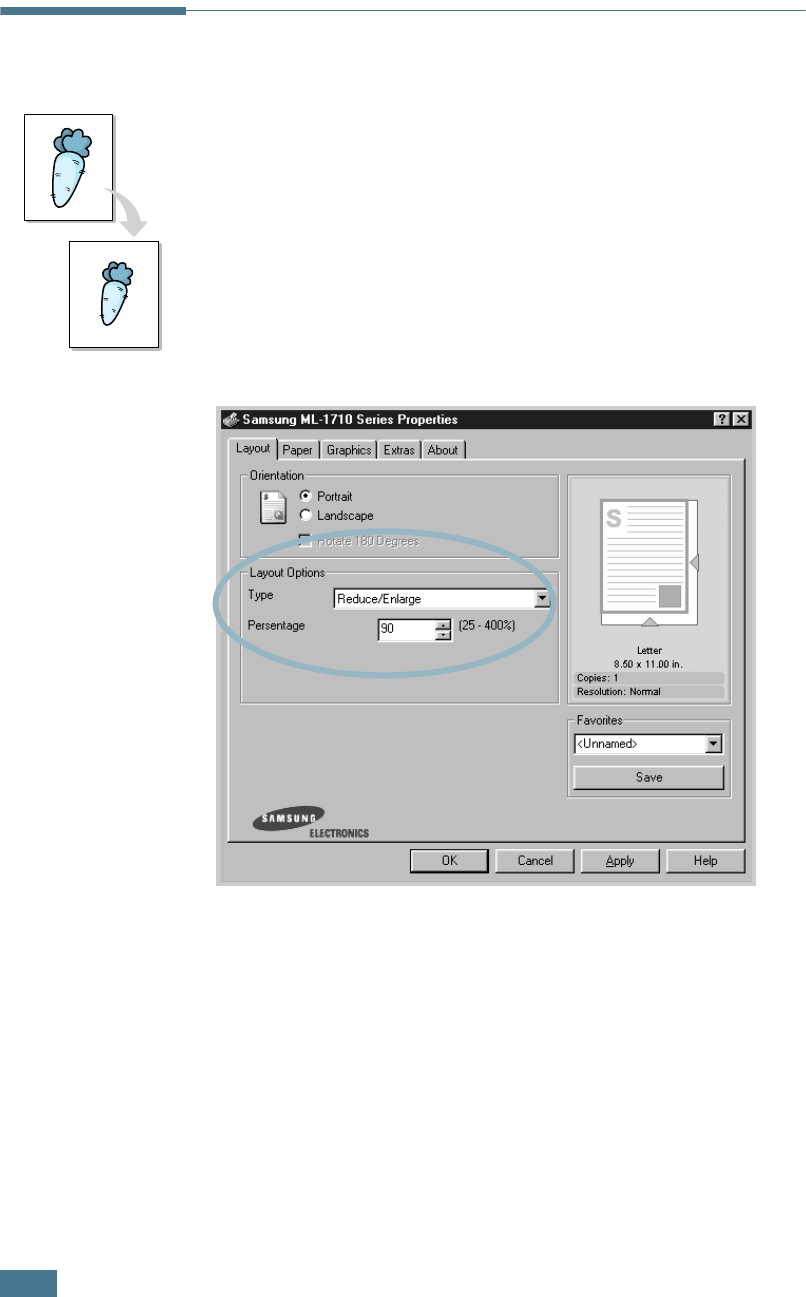
P
RINTING
T
ASKS
4.12
Scaling Your Document
You can scale your print job on a page.
1
When you change the print settings from your software
application, access the printer properties. See page 4.2.
2
From the Layout tab, and select Reduce/Enlarge in the
Type drop-down list.
3
Enter the desired scaling rate in the Persentage input box.
You can also click the ➐☎or ❷ button.
4
Click the Paper tab, select the paper source, size and type.
5
Click OK and print the document.

P
RINTING
T
ASKS
4.13
4
Fitting Your Document to a Selected
Paper Size
This printer feature allows you to scale your print job to any
selected paper size regardless of the digital document size. This
can be useful when you want to check fine details on a small
document.
1
When you change the print settings from your software
application, access the printer properties. See page 4.2.
2
From the Layout tab, and select Fit to Page in the Type
drop-down list.
3
Select the correct size from the Target Paper drop-down
list.
4
Click the Paper tab, select the paper source, size and type.
5
Click OK and print the document.
A
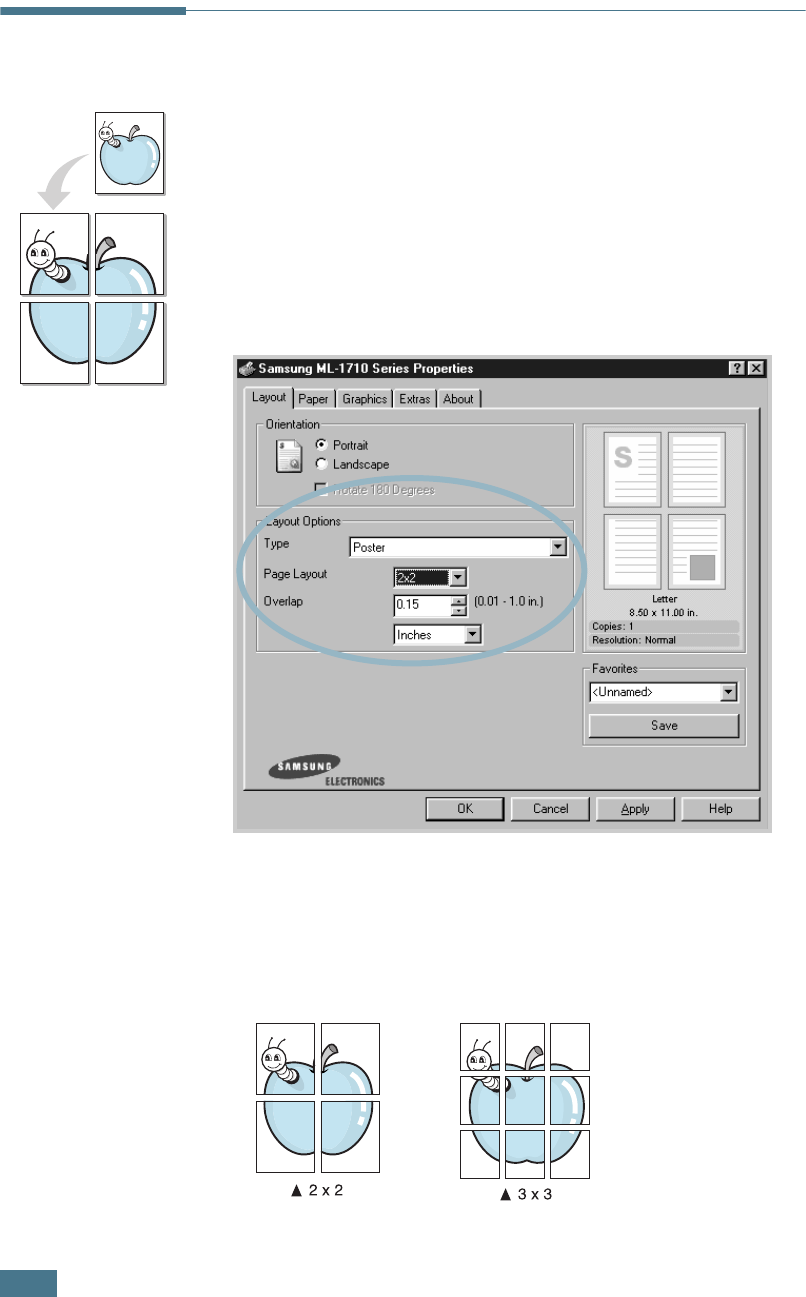
P
RINTING
T
ASKS
4.14
Printing Posters
This feature allows you to print a single-page document onto 4,
9, or 16 sheets of paper, for the purpose of pasting the sheets
together to form one poster-size document.
1
When you change the print settings from your software
application, access the printer properties. See page 4.2.
2
Click the Layout tab, and select Poster in the Type drop-
down list.
3
Configure the poster option:
You can select the page layout from 2x2, 3x3, or 4x4. If you
select 2x2, the output will be automatically stretched to
cover 4 physical pages.
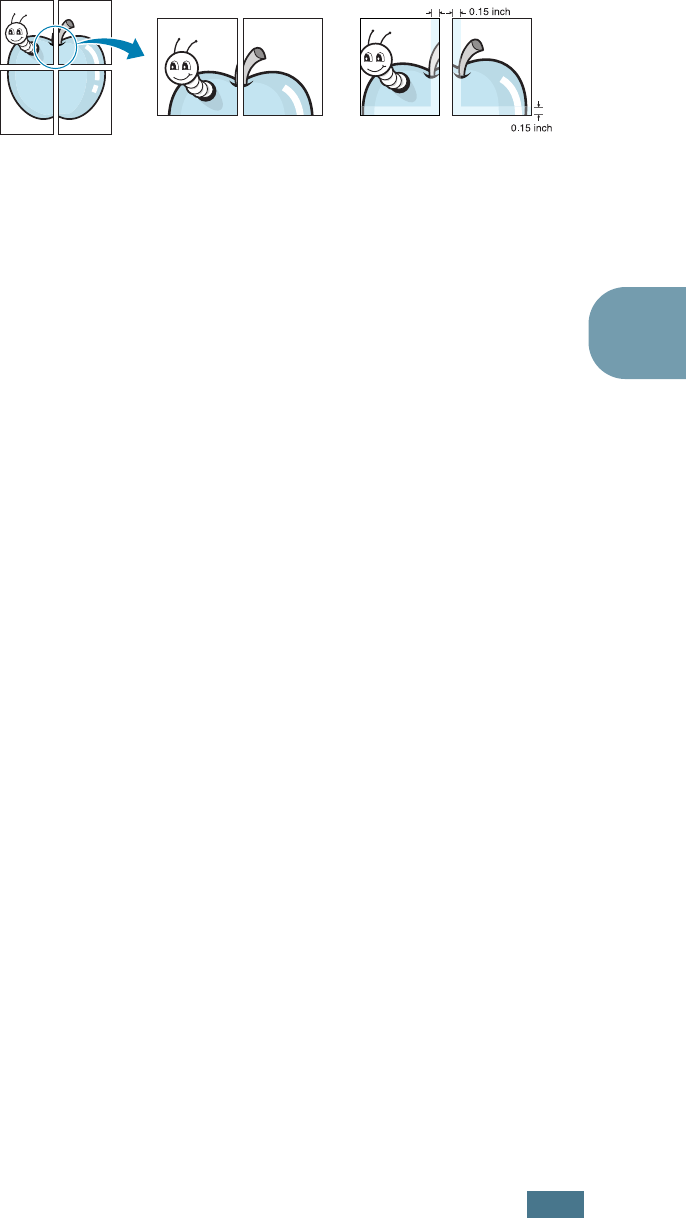
P
RINTING
T
ASKS
4.15
4
Specify an overlap in millimeter or inch to make it easier to
reconstruct the resulting poster.
4
Click the Paper tab, select the paper source, size and type.
5
Click OK and print the document. You can complete the
poster by reconstructing the results.
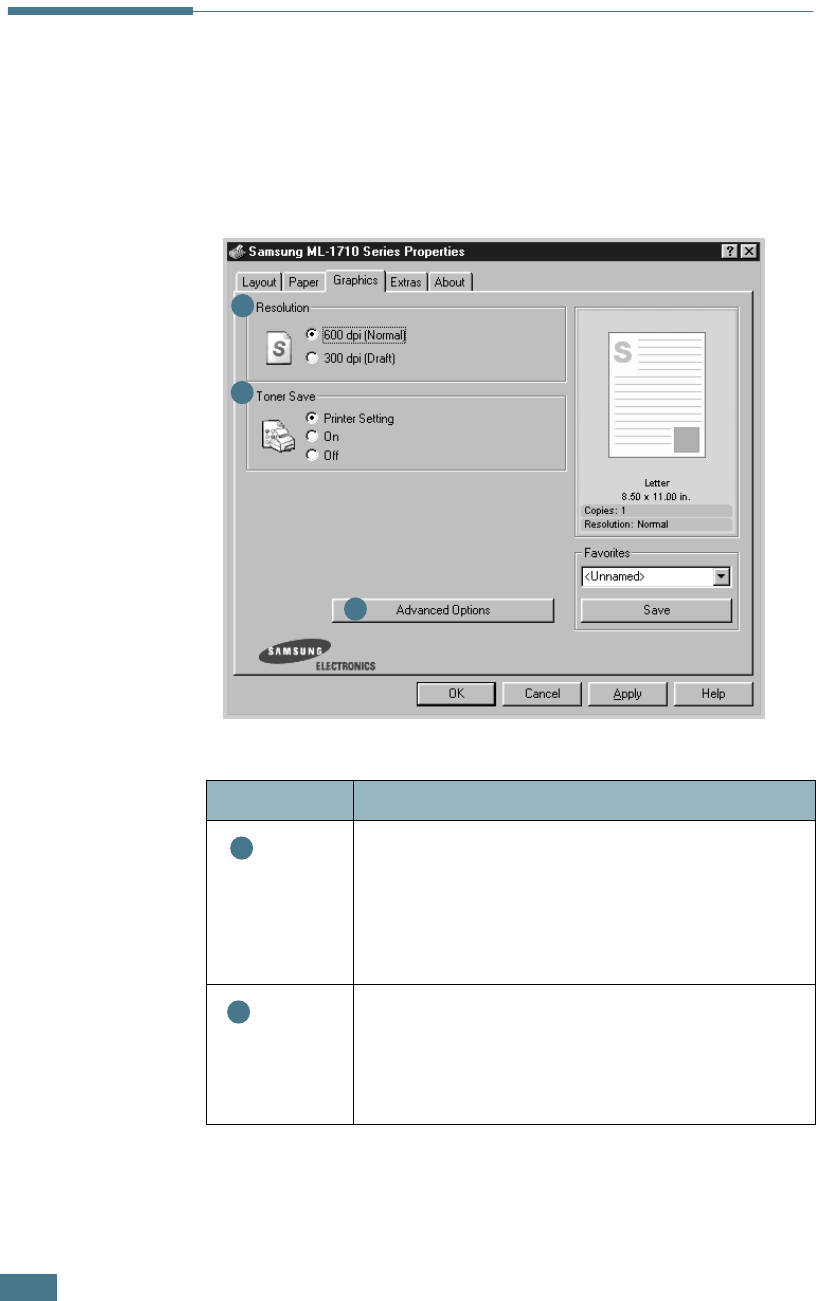
P
RINTING
T
ASKS
4.16
Setting Graphic Properties
Use the following Graphic options to adjust the print quality for
your specific printing needs. See page 4.2 for more information
on accessing printer properties.
Click the Graphics tab to display the properties shown below.
Property Description
Resolution
You can select the printing resolution by
choosing from 600 dpi (Normal) or 300
dpi (Draft). The higher the setting, the
sharper the clarity of printed characters and
graphics. Higher settings may increase time
it takes to print a document.
Toner Save
Selecting this option will extend the life of
your toner cartridge and reduce your cost per
page without a significant reduction in print
quality. For detailed information about this
mode, see page 4.8.
➀
➁
➂
➀
➁
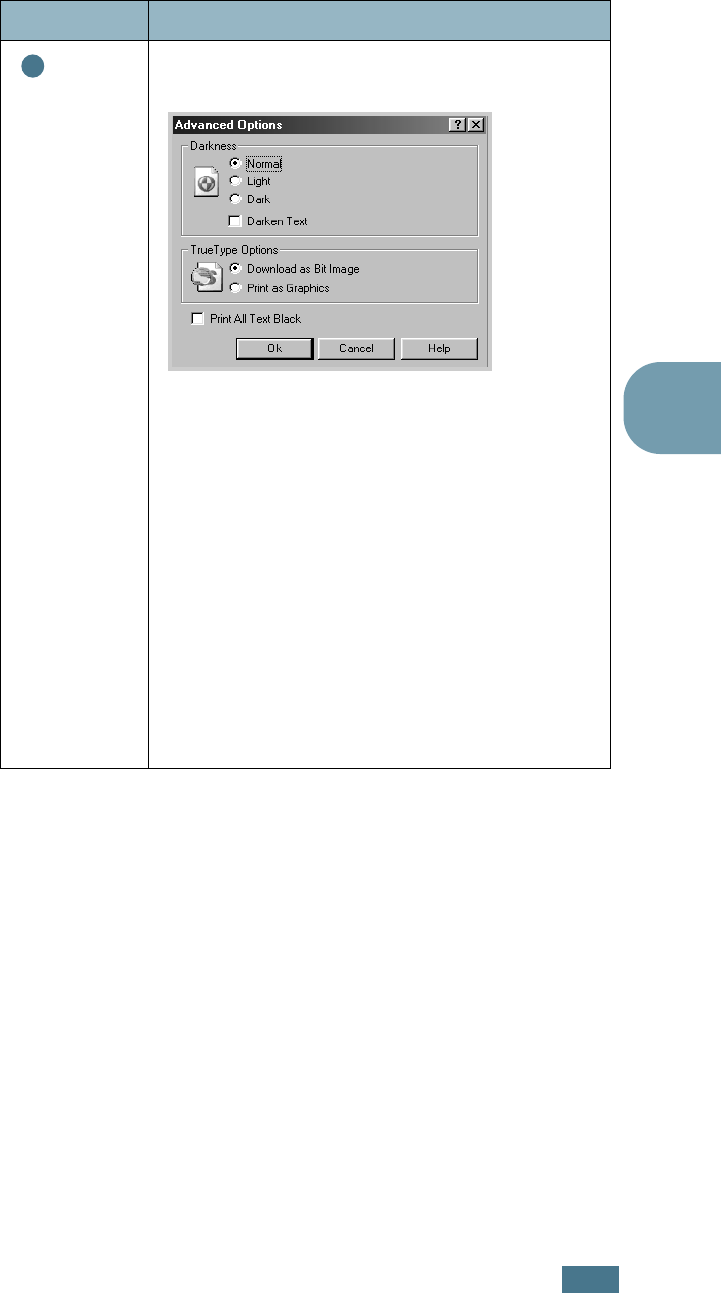
P
RINTING
T
ASKS
4.17
4
Advanced
Options
You can set advanced settings by clicking the
Advanced Options
button.
Darkness
Use this option to lighten or darken the image
appearance in your print.
•
Normal
: This setting is for normal
documents.
•
Light
: This setting is for bolder line widths or
darker gray-scale images.
•
Dark
: This setting is for finer line width,
higher definition in graphics, and lighter gray-
scale images.
When the
Darken Text
option is checked, all
text in your document is allowed to print darker
than a normal document.
Property Description
➂

P
RINTING
T
ASKS
4.18
Advanced
Options
(continued)
True-Type Options
This option determines what the driver tells the
printer about how to image the text in your
document. Select the appropriate setting
according to the status of your document.
•
Download as Bit Image
: When this option
is selected, the driver will download the font
data as bitmap images. Documents with
complicated fonts, such as Korean or Chinese,
or various types of fonts will print faster in
this setting.
•
Print as Graphics
: When this option is
selected, the driver will download any fonts as
graphics. When printing documents with high
graphic content and relatively few TrueType
fonts, printing performance (speed) may be
enhanced in this setting.
When the
Print All Text Black
is checked, all
text in your document is allowed to print solid
black, regardless of the color it appears on the
screen. When it is not checked, colored text is
allowed to print in shades of gray.
Property Description
➂